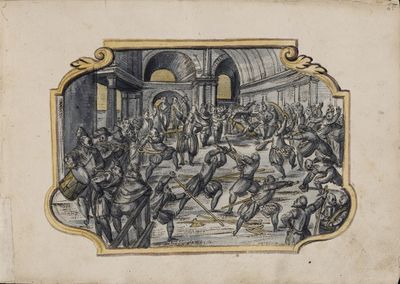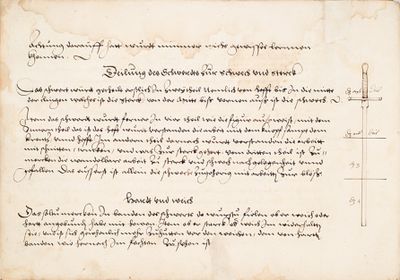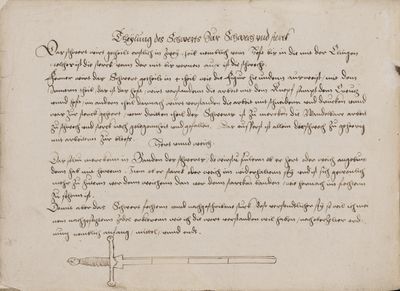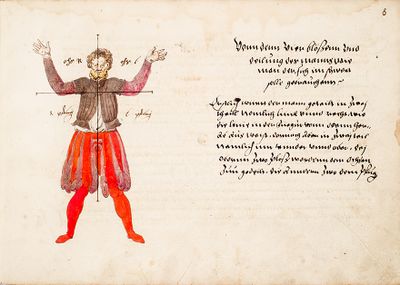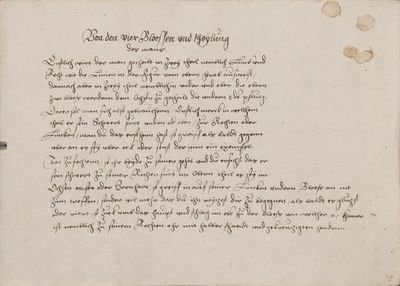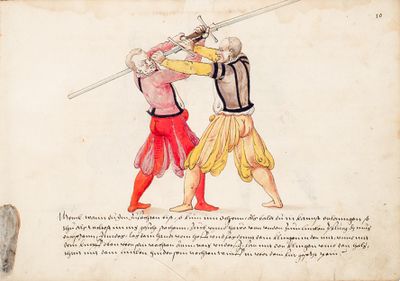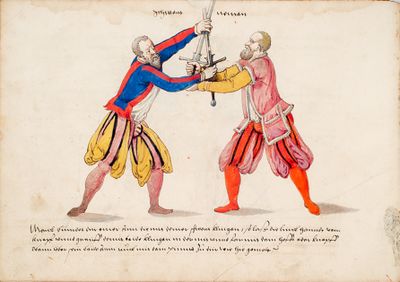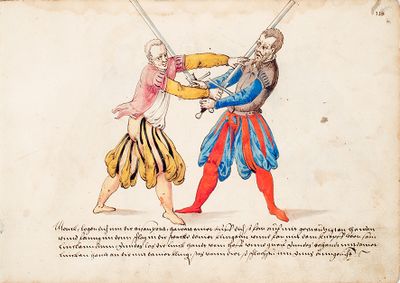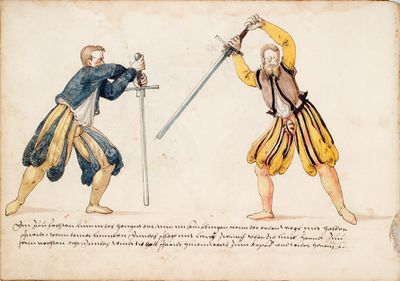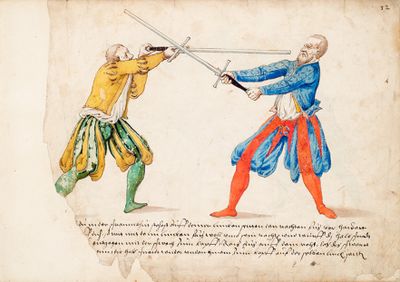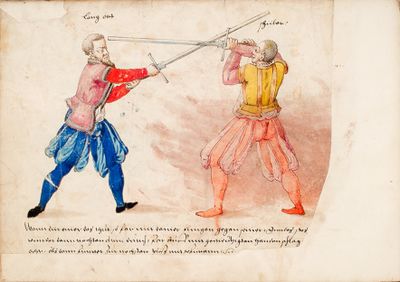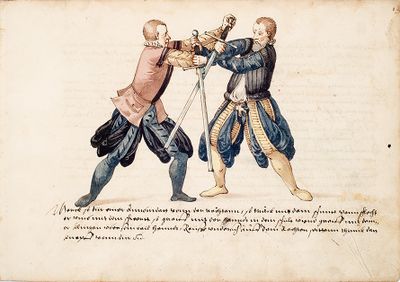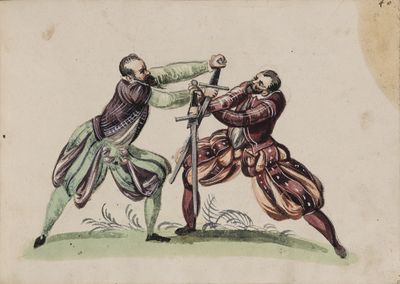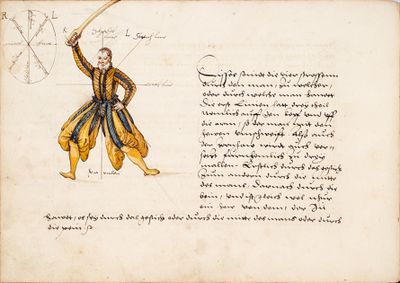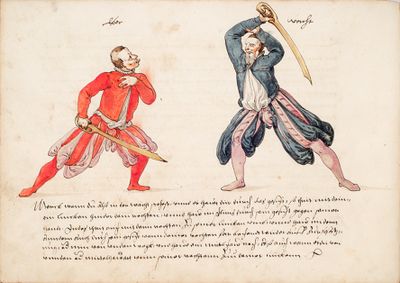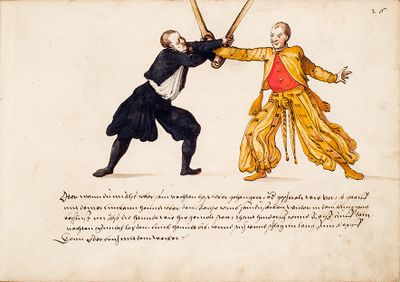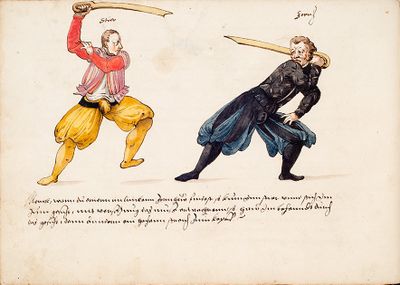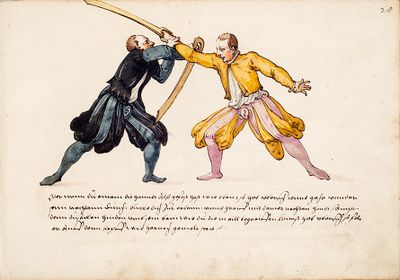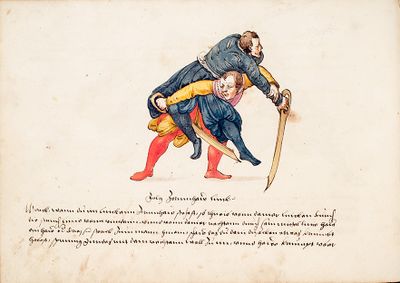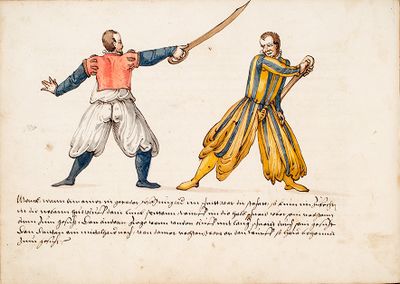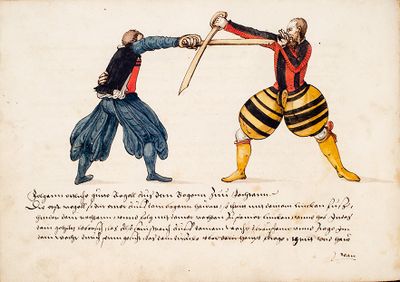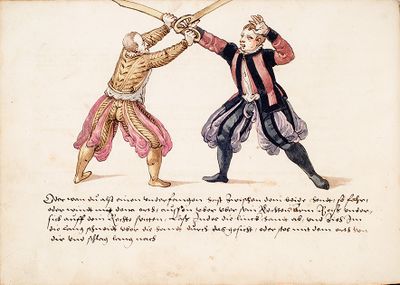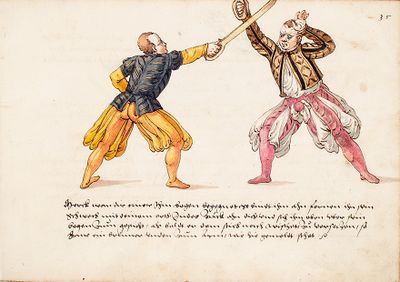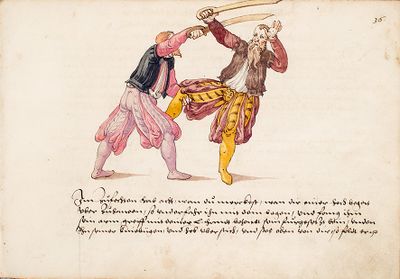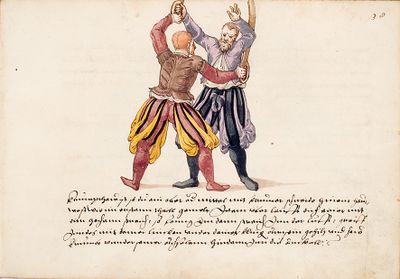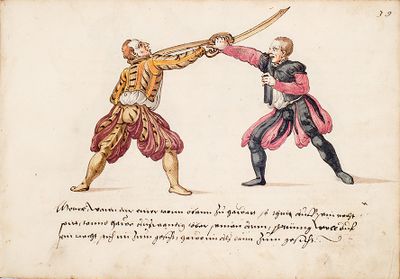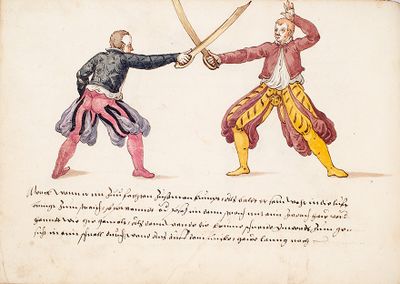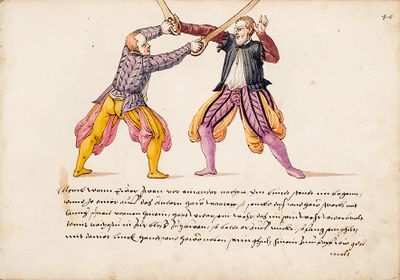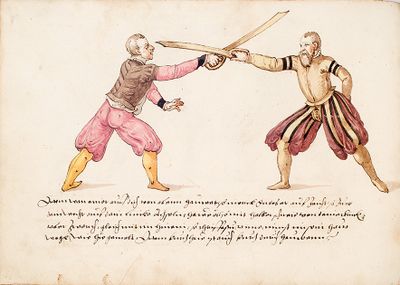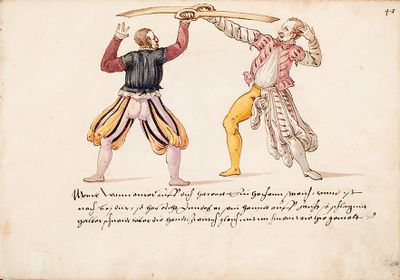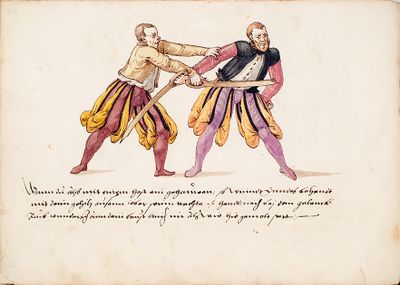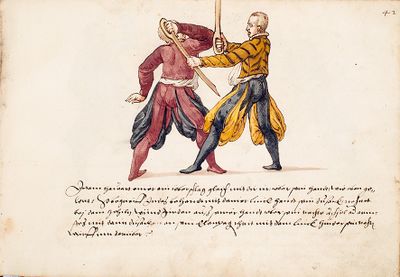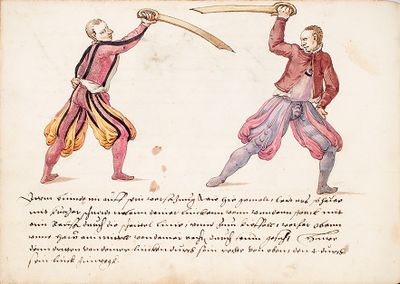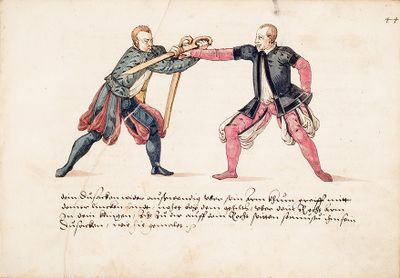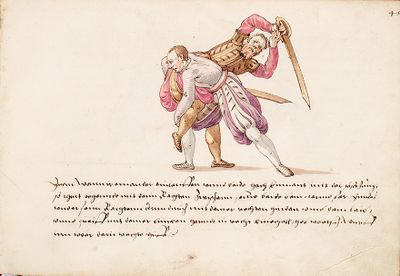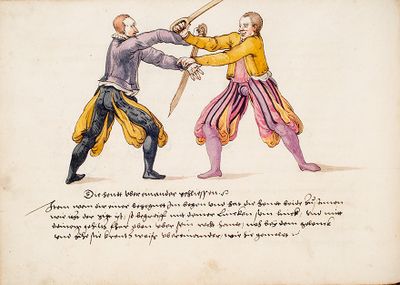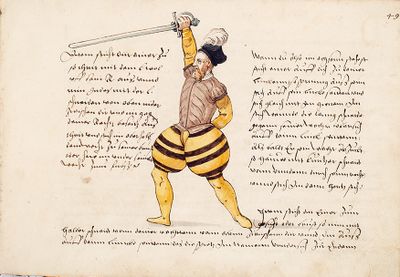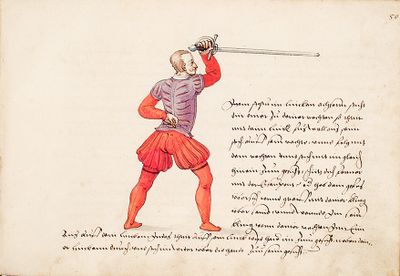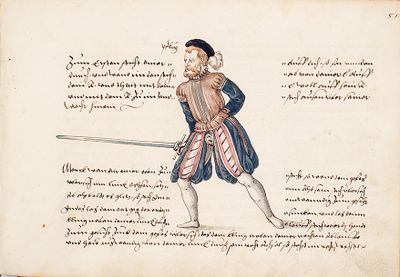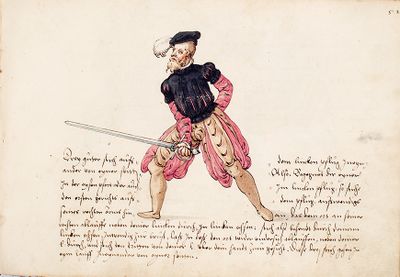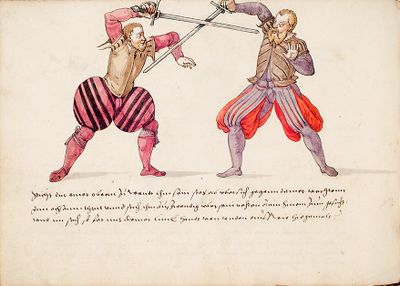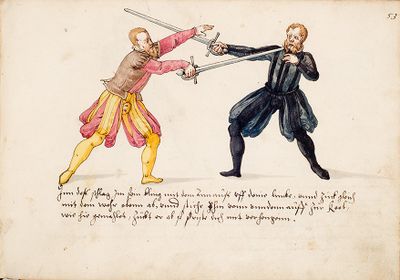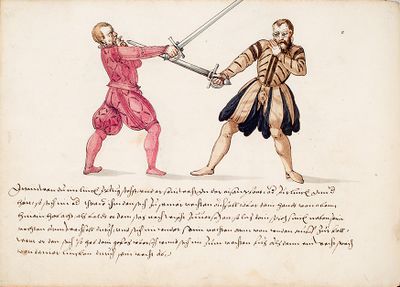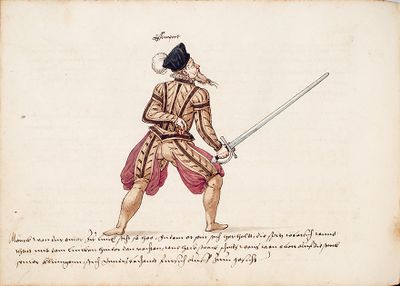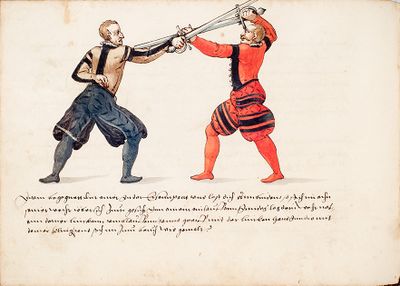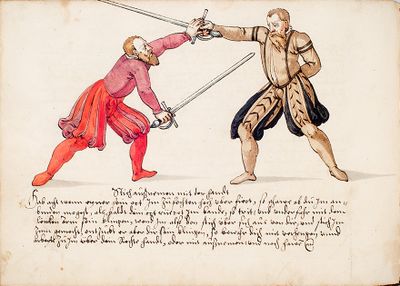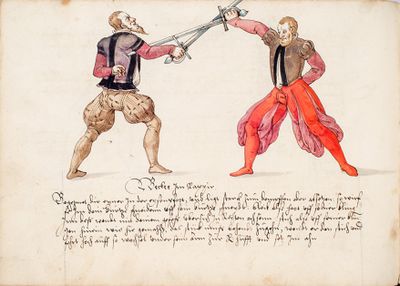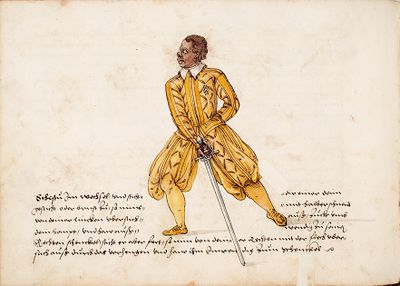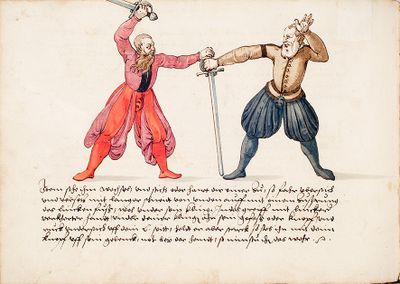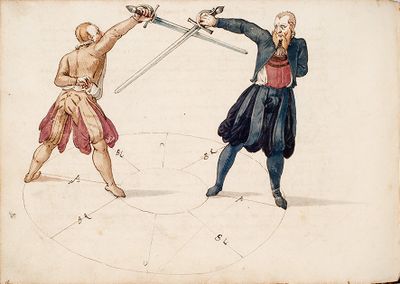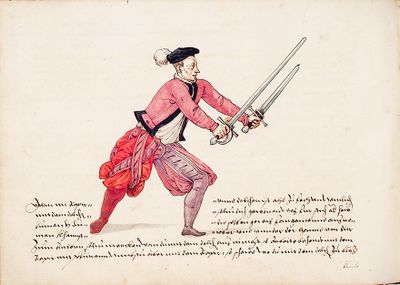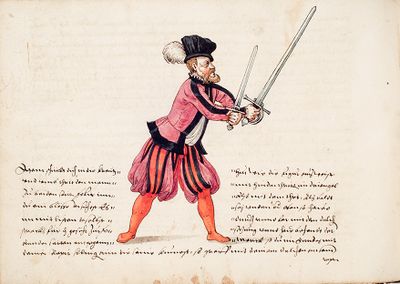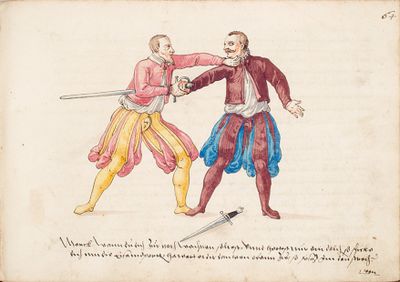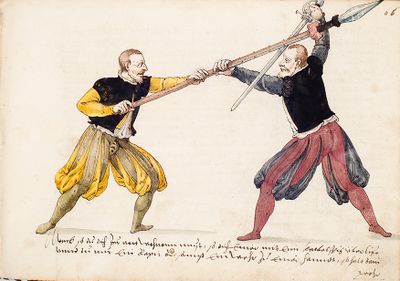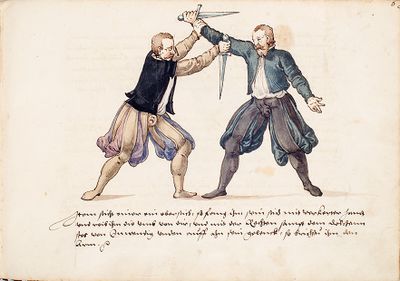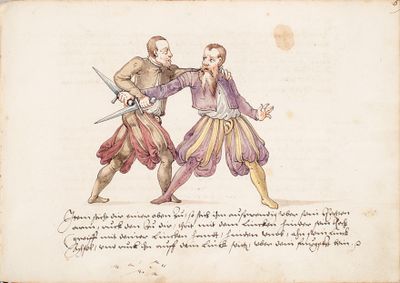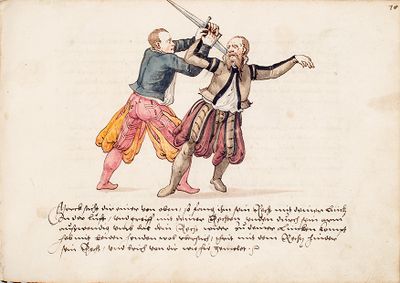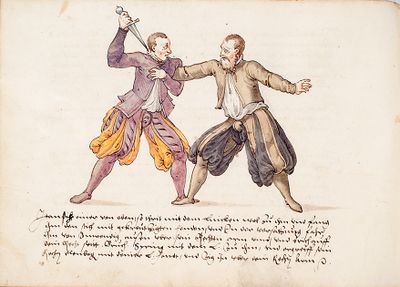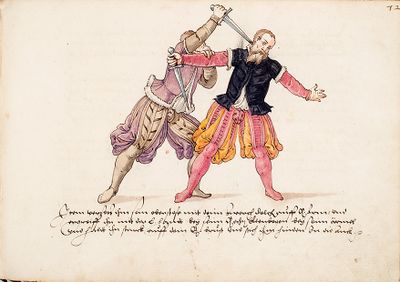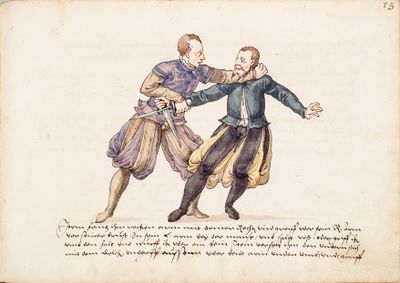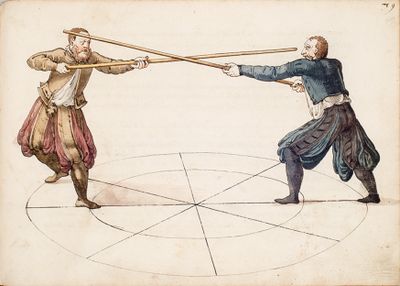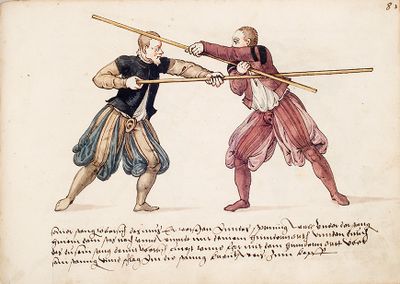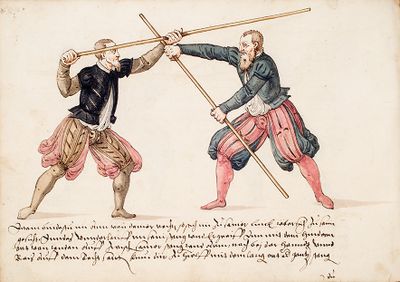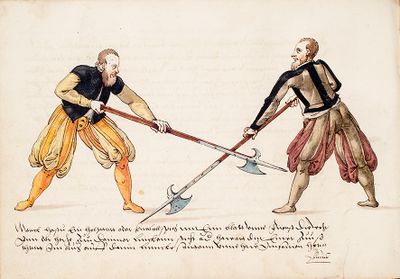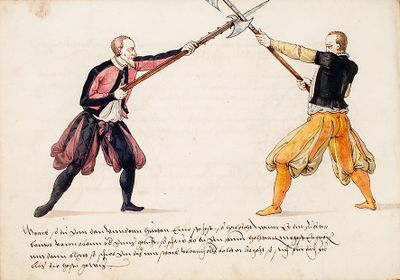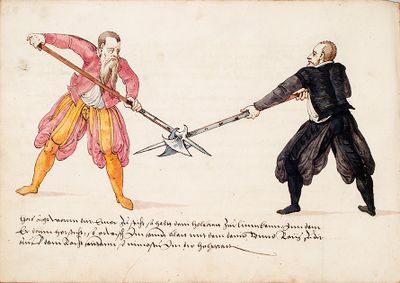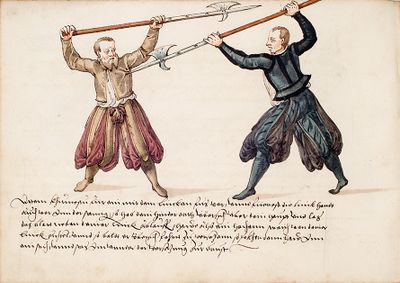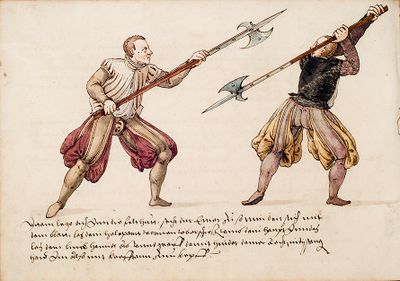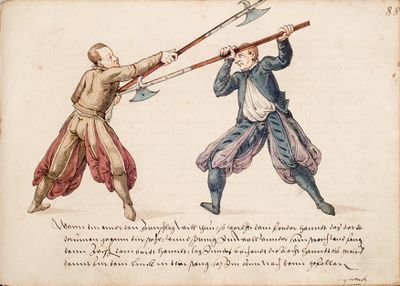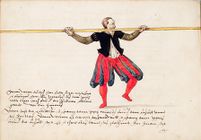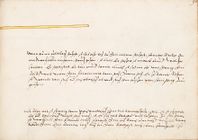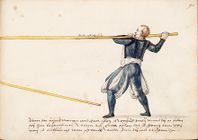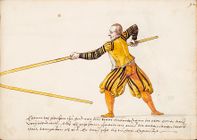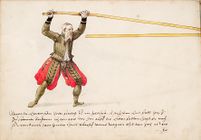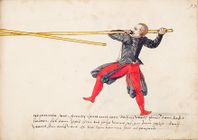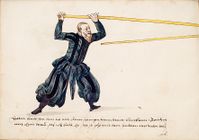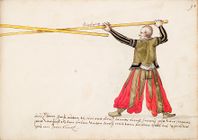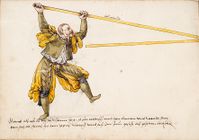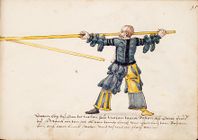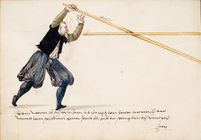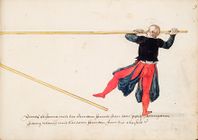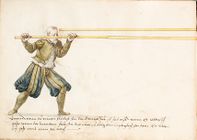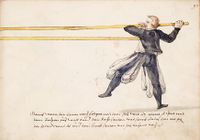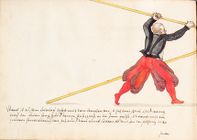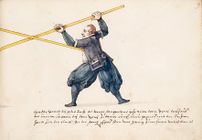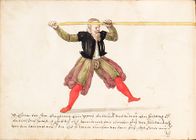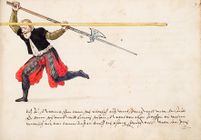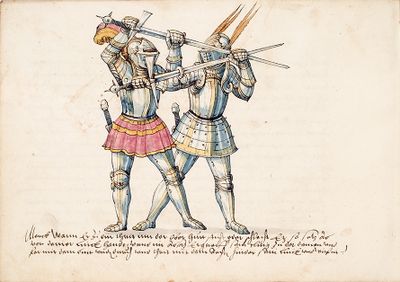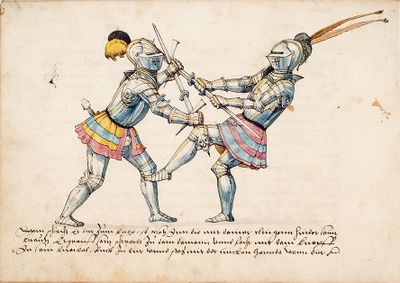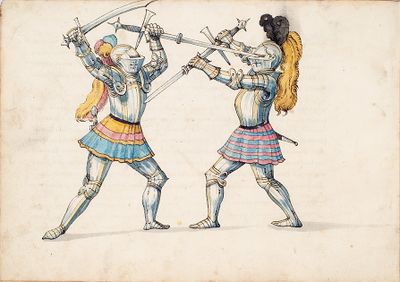|
|
You are not currently logged in. Are you accessing the unsecure (http) portal? Click here to switch to the secure portal. |
Difference between revisions of "Joachim Meyer/Manuscript Comparison"
| Line 1: | Line 1: | ||
| + | == Sword == | ||
| + | |||
{| class="master" style="width: 150em;" | {| class="master" style="width: 150em;" | ||
|- | |- | ||
| Line 789: | Line 791: | ||
|} | |} | ||
| − | |||
| − | + | == Dusack == | |
| − | |||
| − | |||
| − | |||
| − | |||
| − | |||
| − | |||
| − | |||
| − | |||
| + | {| class="master" style="width: 150em;" | ||
|- | |- | ||
| − | + | ! <p>Illustrations (from the Munich)</p> | |
| − | + | ! <p>Illustrations (from the Lund)</p> | |
| − | + | ! <p>{{rating|c|Draft Translation (from the Munich)}} (2022)<br/>by [[Kevin Maurer]]</p> | |
| − | <p> | + | ! <p>{{rating|c|Draft Translation (from the Lund)}} (2012)<br/>by [[Kevin Maurer]]</p> |
| − | + | ! <p>[[Joachim Meyers Fechtbuch (MS Bibl. 2465)|Munich Manuscript]] (1561){{edit index|Joachim Meyers Fechtbuch (MS Bibl. 2465)}}<br/>Transcribed by [[Olivier Dupuis]]</p> | |
| − | + | ! <p>[[Joachim Meyers Fäktbok (MS A.4º.2)|Lund Manuscript]] (1563-8){{edit index|Joachim Meyers Fäktbok (MS A.4º.2)}}<br/>Transcribed by [[Olivier Dupuis]] and [[Dierk Hagedorn]]</p> | |
| − | |||
| − | |||
| − | |||
| − | |||
| − | |||
| − | |||
| − | |||
| − | |||
| − | |||
| − | |||
| − | |||
| − | |||
| − | |||
| − | |||
| − | |||
| − | |||
| − | |||
| − | |||
| − | |||
| − | |||
| − | |||
| − | |||
| − | |||
| − | |||
| − | <p> | ||
| − | |||
| − | |||
| − | |||
| − | |||
| − | |||
| − | |||
| − | |||
| − | |||
| − | |||
| − | |||
| − | |||
| − | |||
| − | |||
| − | |||
| − | |||
| − | |||
| − | |||
| − | |||
| − | |||
| − | |||
| − | |||
| − | |||
| − | |||
| − | |||
| − | |||
| − | |||
| − | |||
| − | |||
| − | |||
| − | |||
| − | |||
| − | |||
| − | |||
| − | |||
| − | |||
| − | |||
| − | |||
| − | |||
| − | |||
| − | |||
| − | |||
| − | |||
| − | |||
| − | |||
| − | |||
| − | |||
| − | |||
| − | |||
| − | |||
| − | |||
| − | |||
| − | |||
| − | |||
| − | |||
| − | |||
| − | |||
| − | |||
| − | |||
| − | |||
| − | |||
| − | |||
| − | |||
| − | |||
| − | |||
| − | |||
| − | |||
| − | |||
| − | |||
| − | |||
| − | |||
| − | |||
| − | |||
| − | |||
| − | |||
| − | |||
| − | |||
| − | |||
| − | |||
| − | |||
| − | |||
| − | |||
| − | |||
| − | |||
| − | |||
| − | |||
| − | |||
| − | |||
| − | |||
| − | |||
| − | |||
| − | |||
| − | |||
| − | |||
| − | |||
| − | |||
| − | |||
| − | |||
| − | |||
| − | |||
| − | |||
| − | |||
| − | |||
| − | |||
| − | |||
| − | |||
| − | |||
| − | |||
| − | |||
| − | |||
| − | |||
| − | |||
| − | |||
| − | |||
| − | |||
| − | |||
| − | |||
| − | |||
| − | |||
|- | |- | ||
| | | | ||
| − | |||
| − | |||
| − | |||
| − | |||
| − | |||
| − | |||
| − | |||
| − | |||
| − | |||
| − | |||
| − | |||
| − | |||
| − | |||
| − | |||
| − | |||
| − | |||
| − | |||
| − | |||
| − | |||
| − | |||
| − | |||
| − | |||
| − | |||
| − | |||
| − | |||
| − | |||
| − | |||
| − | |||
| − | |||
| − | |||
| − | |||
| − | |||
| − | |||
| − | |||
| − | |||
| − | |||
| − | |||
| − | |||
| − | |||
| − | |||
| − | |||
| − | |||
| − | |||
| − | |||
| − | |||
| − | |||
| − | |||
| − | |||
| − | |||
| − | |||
| − | |||
| − | |||
| − | |||
| − | |||
| − | |||
| − | |||
| − | |||
| − | |||
| − | |||
| − | |||
| − | |||
| − | |||
| − | |||
| − | |||
| − | |||
| − | |||
| − | |||
| − | |||
| − | |||
| − | |||
| − | |||
| − | |||
| − | |||
| − | |||
| − | |||
| − | |||
| − | |||
| − | |||
| − | |||
| − | |||
| − | |||
| − | |||
| − | |||
| − | |||
| − | |||
| − | |||
| − | |||
| − | |||
| − | |||
| − | |||
| − | |||
| − | |||
| − | |||
| − | |||
| − | |||
| − | |||
| − | |||
| − | |||
| − | |||
| − | |||
| − | |||
| − | |||
| − | |||
| − | |||
| − | |||
| − | |||
| − | |||
| − | |||
| − | |||
| − | |||
| − | |||
| − | |||
| − | |||
| − | |||
| − | |||
| − | |||
| − | |||
| − | |||
| − | |||
| − | |||
| − | |||
| − | |||
| − | |||
| − | |||
| − | |||
| − | |||
| − | |||
| − | |||
| − | |||
| − | |||
| − | |||
| − | |||
| − | |||
| − | |||
| − | |||
| − | |||
| − | |||
| − | |||
| − | |||
| − | |||
| − | |||
| − | |||
| − | |||
| − | |||
| − | |||
| − | |||
| − | |||
| − | |||
| − | |||
| − | |||
| − | |||
| − | |||
| − | |||
| − | |||
| − | |||
| − | |||
| − | |||
| − | |||
| − | |||
| − | |||
| − | |||
| − | |||
| − | |||
| − | |||
| − | |||
| − | |||
| − | |||
| − | |||
| − | |||
| − | |||
| − | |||
| − | |||
| − | |||
| − | |||
| − | |||
| − | |||
| − | |||
| − | |||
| − | |||
| − | |||
| − | |||
| − | |||
| − | |||
| − | |||
| − | |||
| − | |||
| − | |||
| − | |||
| − | |||
| − | |||
| − | |||
| − | |||
| − | |||
| − | |||
| − | |||
| − | |||
| − | |||
| − | |||
| − | |||
| − | |||
| − | |||
| − | |||
| − | |||
| − | |||
| − | |||
| − | |||
| − | |||
| − | |||
| − | |||
| − | |||
| − | |||
| − | |||
| − | |||
| − | |||
| − | |||
| − | |||
| − | |||
| − | |||
| − | |||
| − | |||
| − | |||
| − | |||
| − | |||
| − | |||
| − | |||
| − | |||
| − | |||
| − | |||
| − | |||
| − | |||
| − | |||
| − | |||
| − | |||
| − | |||
| − | |||
| − | |||
| − | |||
| − | |||
| − | |||
| − | |||
| − | |||
| − | |||
| − | |||
| − | |||
| − | |||
| − | |||
| − | |||
| − | |||
| − | |||
| − | |||
| − | |||
| − | |||
| − | |||
| − | |||
| − | |||
| − | |||
| − | |||
| − | |||
| − | |||
| − | |||
| − | |||
| − | |||
| − | |||
| − | |||
| − | |||
| − | |||
| − | |||
| − | |||
| − | |||
| − | |||
| − | |||
| − | |||
| − | |||
| | | | ||
| <p><small>[1]</small> '''Fencing in Dussack and the use of all types of single hand weapons'''</p> | | <p><small>[1]</small> '''Fencing in Dussack and the use of all types of single hand weapons'''</p> | ||
<p>First of all, there are the guards, of which there are six, which are not made to be waited in, as mentioned above in part, but rather for the sake of division, so that one knows how to distinguish one from the other, when one fights from Steer, he should or must use the usual cut and ''Stuck'' that are assigned to the Steer, if one wants to fence with someone, he shall take care of which or by which part he fights against him, so that he may know with which cut or ''Stuck'' he should attack him most effectively, so that he may deprive him of the Before, because the fencers who carelessly strike their blows and ''Stucke'' are soon hit and usually have to go away with damage.</p> | <p>First of all, there are the guards, of which there are six, which are not made to be waited in, as mentioned above in part, but rather for the sake of division, so that one knows how to distinguish one from the other, when one fights from Steer, he should or must use the usual cut and ''Stuck'' that are assigned to the Steer, if one wants to fence with someone, he shall take care of which or by which part he fights against him, so that he may know with which cut or ''Stuck'' he should attack him most effectively, so that he may deprive him of the Before, because the fencers who carelessly strike their blows and ''Stucke'' are soon hit and usually have to go away with damage.</p> | ||
| + | | <p><small>[1]</small> '''Fencing in Dussack, techniques in all Kinds of One handed Weapons Thorough Descriptions'''</p> | ||
| + | |||
| + | <p>Firstly are the guards, therein are namely Four which are not made so that one should wait in them how it is previously and partially reported above in the sword. But rather has more divisions there with one knows One from the other to distinguish, namely thus, when one fights from the Steer, he will generally use such Strikes and ''Stücken'', that are assigned to the Steer therefore he who will fight with them, thus should he pay attention from which or through which division he goes against in fighting, thus that he may know best, with what cuts or ''Stücken'' he should lay on against him, in that he in the Before runs off, then your fighting and your cuts to him and techniques will be correctly cut in and soon put, it must usually give way to harm.</p> | ||
| {{paget|Page:MS Bibl. 2465|022r|jpg|lbl=22r}} | | {{paget|Page:MS Bibl. 2465|022r|jpg|lbl=22r}} | ||
| + | | | ||
| + | {{paget|Page:MS A.4º.2|44r|jpg|p=1}} {{section|Page:MS A.4º.2 44v.jpg|1|lbl=44v.1|p=1}} | ||
|- | |- | ||
Revision as of 03:26, 11 April 2024
Contents
Sword
Illustrations (from the Munich) |
Illustrations (from the Lund) |
Munich Manuscript (1561) |
Lund Manuscript (1563-8) | ||
|---|---|---|---|---|---|
[1] Firstly will each one of the actions in Fencing be divided into three parts which are particularly good to note. Attacking, following after, withdrawal or ending, then to the first in the onset send your attacks through the guards and cuts like they follow afterwards here, however to the other parts and the middle work, this will be reprinted with the handworks, and a mixture of convenient cuts. And lastly to the ending, or the withdrawal, how orderly each one will hereafter be diligently written and taught. |
[1] Sword Fencing Firstly will each one of the actions in Fencing be divided into three parts which are particularly good to note. In the Sword this is namely attacking, followed by the withdrawal or other than to the first to reach it, send your attacks through the guards and cut like they follow afterwards here, however to the other parts and the middle work, this will be reprinted with the handworks, and a mixture of convenient cuts. Onwards to the last, or the withdrawal, how orderly each one will hereafter be diligently written and taught. |
[1r.1] Zum Ersten wurdt ein Ider gang Im Fechten getheilt In drej theil, welches sonderlich wol zumercken ist Nemlich Angreiffen, Nachvolgen, Abziehen oder enden. Als zum Ersten Im zugang geschicht der Angriff durch die leger vnd haw, wie sie hernach volgen werden. Im andern theil aber, vnd Mittel arbeit, wurdt nachgedruckt mit der Handt arbeit vnd vermischung füglicher haw, vnd zum letzsten das Enden vnnd abziehen wie ein Jedes ahn seinem Orth fleissig hernach beschriben vnd gelertt wurdt. |
[6r.1] Schwert Fechtenn Erstlich wirt ein jeder gang in fechtenn getheilt in drey theil welches sonderlich wol zu mercken ist in schwerdt, nemblich angreiffenn nachfolgenn, abzihenn, oder enden als zum erstenn in zugann, geschicht der angruff durch die leger unnd haw wie sie hernach folgen werdenn, in andern theil aber und mitler arbeit wirdt nachgedruckt mit der handtarbeit, und vermischung fuglicher hew. Weiter zum letsten das enden oder abzihenn wie es ordentlich ein jeder am seinem orth hernach fleissig beschribenn unnd gelehrt wurt. | ||
[2] Further, you should note the Before and After, Weak and Strong. The Before is when you drive with your Stücken so that he cannot come to his senses, especially by positioning yourself as close as he is, and how he defends before your Stücken and these same wants to break and bar, with this, he runs off the Before to you. The After is, when you have been rushed upon by your opponent how it is reported above. Thus you should respond Indes quickly with convenient work, with this, you are strongest on his Stücken, when you go on with your work in the Before, and in this you are crowded so that you must displace him After, thus is a constant changing with the Before and After, now you have it, then he does, but he who does not pay attention to it, he will never learn to fence. |
[2] Secondly one should note the Before and After, Weak and Strong. The Before is when you drive with your Stücken so that he cannot come to his senses, especially by positioning yourself close, and how he defends before your Stücken and these same would like to break and bar, with this, he runs off the Before to you. The After is, when you have been rushed upon by your opponent how it is reported next and above. Thus you should respond Indes quickly with convenient work, with this, you are strongest on his Stücken, when you lay on with your work in the Before, and in this you are crowded so that you must displace him after, thus is a constant changing with the Before and After, now you have it, then he does. But he who does not pay attention to it, he will nonetheless never learn to fence. |
[1r.2] Weitter sol man mercken vff das, vor, vnd Nach, schwech, vnd Stercke, Das vor ist so du den man mit deinen stucken dahin treibest, das er zu seinem furnhemen nit khan khommen, sonder mit versetzen sich engsten, wie er sich vor dir schitzen, deine stuck brechen, vnd sperren moge, damit er dir das, vor, ablauffe. Das nach ist, wan du also von deinem gegen man vber eylt wurst, wie oben gemeldt so soltu Indes behendt mit füglicher arbeit Im begegnen, damit du Ihn steckest In seinen stucken vnd also mit deiner arbeit, Ihm das, vor, abiagest, vnd ihn also tringst dir zu versetzen Im, Nach, Also ist ein stetter Wechsel mit dem Vor, vnd mit dem Nach, das es itst disser, dhan Jenner hatt, welcher auch nit [1v.1] Achtung darauff hatt wurdt nimmer nichs gewisses lernnen khennen. ⁋ |
[6r.2] Zum andern sol man mercken auf das vor, und nach, schweche und stercke. Das vor ist so du den man mit deinen stuckenn dohin treibest das er zu seinem furnemen nicht khomen kan, sonder mit versetzenn sich engstenn wie er sich vor deinem stucken schutzen und dieselbenn brechen unnd sperrrenn muge, domit er dir das vor, ablauffe. Das nach ist, wan du also von deinem gegenman ubereilt wurst wie negst oder obenn gemelt, so soltu indes behendt mit fuglicher arbeit, in begegnenn, domit du in steckest in seinenn stuckenn, und also mit deiner arbeit in das vor ab jagest und in also tringest dir zu versetzenn in nach. Also ist ein steter wechsel mit dem vor unnd nach, das es jetzt disser dann jener hat, welcher auch nicht achtung darauff hot, wirdt nimmer nichts gewisses lernen fechten. | ||
[3] Divisions of the sword to the Weak and Strong The Sword is firstly divided in two parts, namely from the grip to the middle of the blade which is known as the Strong, from the middle to the most forward, is the Weak. |
[3] Divisions of the sword to the Weak and Strong The Sword is firstly divided in two parts, namely from the grip to the middle of the blade which is known as the Strong, from the middle to the most forward, is the Weak. |
[1v.2] Teilung des schwerdts zur schwech und sterck Das schwert würdt getheilt erstlich in zwey theil Nemlich von hefft bis In die mitte der clingen welches ist die sterck, von der Mitte biß vornen auß ist die schwech. ¶ |
[6v.1] Theylung des Schwerts zur Schwech und sterck Das schwert wirt getheilt erstlich in zwey theil nemblich vom heft bis in die mit der clingen welches ist die sterck vonn der mit bis vornen auß ist die schweche. | ||
[4] Item: The sword is further divided in four parts how the figure shows. With the inward part, that is the haft, and (with it) the work with the pommel and cross and haft will be understood, in the next part, thereafter will the work with cutting and pushing and what belongs to the Strong be understood, to the third part of the sword should be noted the alterable work of the Weak and Strong after opportunity and liking. Which alone is extremely weak for you to work properly to the Openings. |
[4] Furthermore is the sword divided in four parts how the figure below this shows. With the inward part, that is the haft, and [with it] the work with the pommel and cross and haft will be understood, in the next part, thereafter will the work with cutting and pushing and what belongs to the Strong be understood, to the third part of the sword should be noted the alterable work of the Weak and Strong after opportunity and liking. Which alone is extremely weak for you to work properly to the Openings. |
[1v.3] Item das schwerdt wurdt ferner In vier theil wie die figur außweist, mit dem Innern theil das ist das heft wurdt verstanden die arbeit mit dem knopf sampt dem kreutz, vnd hefft Im andern theil darnach wurdt verstanden die arbeitt mit schnitten, trucken, vnd was zur sterck gehort. vom dritten theil ist zumercken die wandelbare arbeit zu sterck vnd schwech nach gelegenheit vnnd gefallen Das eusserst ist allein die schweche zugehorig mit arbeitten zur blöß. |
[6v.2] Ferner wirt das schwert getheilt in 4 theil wie die figur hie undenn ausweist, mit dem innern theil, das ist das heft, wirt verstandenn die arbeit mit dem knopf sampt dem creutz unnd heft, in andern theil darnach wurt verstanden die arbeit mit schneidenn und drucken unnd was zur sterck gehoert. Vom dritten theil des schwerts ist zu mercken die wandelbare arbeit zu schwech und sterck nach gelegennheit und gefallen. Das ausserst ist allein der[1] schwech zu gehoerig mit arbeitenn zur bloeß. | ||
[5] Hard and Soft Thus you shall mark in the binding of the swords, as you shall feel if he has become hard or soft in the bind, with the cut. Item: If he is yet again, Strong or Weak, and is usually more watchful of the Weak binding before the Strong, how hereafter in the fencing it can be seen. |
[5] Hard and Soft Thus you shall mark in the binding of the swords, as you shall feel if he has become hard or soft in the bind, with the cut. Item: If he is yet again, strong or weak, and is usually more watchful of the weak binding before the strong, how hereafter in the fencing it can be seen. |
[1v.4] Hardt vnd weich Das soltu mercken In banden des schwerts do wurstu fielen ob er weich oder hartt angebunden habe mit hewen. Item ob er starck oder weich Im widerhaltten seie, vnd ist sich gewhonlich mehr zuhutten vor den weichen, dan von dem hartten banden wie hernach Im fechten zu stehen ist |
[6v.3] Hert unnd weich. Das soltu merkenn in banden des schwerts, do wirstu fulenn ob er hert oder weich angebundenn hab mit hewenn. Item ob er starck oder weich in widerhaltenn sey und ist sich gewonlich mehr zu hutenn vor denn weichenn dan vor denn starcken banden, wie hernach in fechtenn zu sehenn ist. | ||
[6] In order that the sword fencing and the following Stuck are understandable, I will explain my following Zedel, how I want the words to have understanding, according to the order N (namely) beginning, middle and end. |
[6] With this however the Sword fencing and the following written Stuck is more understandable thus as I explain my Zedel according to the rules, as I want the words to have understanding so I have named the order; the Beginning, Middle and End. |
[2r.1] Damit aber das schwert fechten vnnd nach geschriebne stuck dester verstendlicher sindt so will ich meinen noch gesezten zedell erkleren wie ich die wortt verstanden wil habenn nach ob erzelter ordnung Nemlich Anfang, Mitel, vnnd Enndt. ¶ |
[6v.4] Domit aber das schwert fechtenn unnd nachgeschribene stuck desto verstendtlicher sey so wil ich meinen nachgesetztenn zedel erklerenn wie ich die wort verstanden wil haben, nach oberzelter ordnung nemblich anfang, mittel, unnd endt. | ||
[7] Zedel The 4 Main Guards, namely Tag, Fool, Ox, Plow. |
[7] Follow the Sword Zedel The Four Main guards From the Roof, Fool, Ox, Plow |
[2r.2] Zedell. Die 4 Hauptleger Nemlich tag, Olber, Ochs, Pflug |
|||
[8] The 8 Secondary Guards, Long Point, Iron Gate, Hanging Point, Speak Window, Key, Side Guard, Barrier Guard and Wrath Guard. |
[8] The Eight Secondary Guards Long-point, Iron Gate, Hanging Point, Speak Window, Key, Side Guard, Barrier Guard, Wrath Guard |
[2r.3] ¶ Die 8 bej leger Lanngort, Eisennport, Henngetort, Sprechfenster, Schließell, Nebennhut, Schranckhut, Zornleger ¶ |
[7r.2] Die Acht bey leger. Langort, Eysenport, Henget ort, Sprechfenster, Schlussel, Nebenhuot, Schranckhuot, Zornleger. | ||
[9] The 5 Master Cuts, Wrath Strike, Crooked Strike, Thwart Strike, Scalp Strike, Squinter Strike. |
[9] The Five Master-Cuts Wrath Cut, Crooked Cut, Thwart Cut, Squinting Cut, Scalper |
[2r.4] Die 5 meister hew. Zornhaw, krumphaw, Zwerhaw, scheittlerhaw Schielaw, |
[7r.3] Die funf meister hew. Zornhaw, Krumphaw, Zwerchhaw, Schylerhaw, Scheideler. | ||
[10] The 6 forbidden Cuts, Blind Cut, Rebound Cut, Short Cut, Joint Cut, Clashing Cut, Winding Cut. |
[10] The Six Covert Cuts Blinding Cut, Bouncing Cut, Short Cut, Knuckle Cut, Clashing Cut, Wind Cut |
[2r.5] Die 6 verborgennhaw. Blindhaw, Brelchaw, Kurtzhaw, Knichellhaw, Glietzhaw, windthaw, |
[7r.4] Die sechs verborgen hew. Blindthaw, Brelhaw, Kurtzhaw, Knuchelhaw, Glutzhaw, Windthaw. | ||
[11] Handworks Binding on, Remaining, Slicing, Striking around, Chasing after, Snapping around, running off, Doubling, Deceiving, Flitting, Failing, Circle, Looping, Winding, Winding through, Reversing, Changing through, Running over, Setting off, Cutting away, Pulling, Hand pushing, Sliding, Hanging, Barring, Blocking, Wrenching out, Gripping over, Weak pushing.[2] |
[11] Handworks in the Sword Bind On, Remain, Cut, Strike Around, Travel After, Snap Around, Run Off, Doubling, Leading, Flying, Feeling, Circle, Looping, Winding, Winding Through, Reverse, Change Through, Run over, Set Off, Cut Off, Pull, Hand Press, Displace, Hanging, Blocking, Barring, Travel out, Grab over, Weak pushing |
[2r.6] Hanndarbeit Annbinden, Bleiben, Schneiden, Vmbschllagen, Nachreisen, Vmbschnappen, Ablaufen, Dopliern, Verfieren, Verfliegenn, Verfelen, zierkel, Rinde, Winden Durchwinden, Verkeren, Durchwechseln, Vberlauffen, Absezen, Abschniden, zucken Hendtrucken, Verschieben, Verhengen, Verstiellen, Speren Außreisenn, übergreifen Schwechstoßenn ./. |
[7r.5] Handarbeit in Schwert. Anbinden, Bleiben, Schneiden, Umbschlagen, Nachreysen, Umbschnappen, Ablauffen, Doplirenn, Verfurenn, Verfligenn, Verfehlen, Zyrckel, Rinde, Winnde, Durchwinden, Verkeren, Durchwechslen, Uberlauffen, Absetzen, Abschneiden, Zucken, Hendttrucken, Verscheiben, Verhengenn, Verstillenn, Sperren, Aussreissen, Ubergreiffenn, Schwech stossen. | ||
[12] Of the 4 Guards First of all, the ancients not only used the 4 guards for good in attacking, but also hid our so-called fencing summarily in them, that namely they had told and intended with all high guards the cuts from above. With the Fool, however, all cuts from below were therefore called Fool, because all things from below are to be regarded as contrary to what comes from above. They have therefore composed their whole fencing in two cuts namely from above and from below so that no cut can be thrown, for it must be from above or from below and even if one cuts a Middle or Thwart Strike, then that cut still has a common name with the High or Low Cut, then just as no Middle Cut can be made, unless it will go somewhat from below or above. So by the Ox and the Plow they intended the thrust, that is, the upper and lower thrust, which, however, in our present time is not in the fencing for several reasons, I will then save Oxen and Plow together with the thrusts until the rapier, where I will then extensively cover it. |
[2r.7] Vonn den 4 hüten ¶ [2v.1] Erstlich habenn die alten, die 4 leger nit alein fier huten im angreiffen gebraucht sonnder habenn auch ir ganntz fechtenn Summarischer weüs darinnen verborgenn gehapt, Als nemlich mit dem tag hawn sie alle hew vonn oben anzeigt vnd gmeint. Mit dem Olber aber alle hew vonn vnden vnnd darumb Olber genent dejweil gmeinlich die ding vonn vnnden einfeltig anzusehen gegen dem was von obem kumpt. Haben also ir ganz fechtenn in zwen hew verfast nemlich ober, vnnd vnnder, dan ir kein haw gehawenn kann werdenn es muß vonn oben oder von vnden sein vnnd ob schon einer ein mitelhaw oder zwerhaw, hawt so hatt der haw doch gemeinschaft einweder mit dem ober oder vnnder, dann so gerad würt kein mitelhaw gehawen er würt etwas von vnden oder obenn gehenn. Also habenn sie mit dem Ochsenn vnnd Pflueg dj stich gemeint nemlich ober vnnd vnnder stich. Dieweill mann aber zu vnserer irziger zeit nit stich im fechten ettliher vrsah halbenn, will ich denn Ochsen vnd Pflueg sampt denn stichen sparen bis ins Rapier, ann welchenn orten ich dan weitleifiger handel wirt ¶ |
||||
[13] But how each guard is to be made or understood will be recorded in figures. |
[2v.2] Wie aber ein jedes leger zumachen oder zuuerstehn sej würt horen in figuren verzeihnet werden. |
||||
[14] Wrath Cut Wrath Cut is done thus, when you are in Zufechten, then come in the Ox or take the sword onto the right shoulder so that the left foot stands forth, step and cut with the long edge from the right diagonally to his left whether to the head or body. |
[2v.3] Zornnhaw Zornnhaw mach also wann du im zufechtenn bist, so kum inn Ochsenn, oder nim das schwert in die recht achseln das der linck fuß vor stehe, trit vnnd haw mit langer schnied vonn der rechten schlims zw seiner lincken es sej zum kopff oder lieb ¶ |
||||
[15] Crooked Cut Stand with the left foot forward, hold the sword to the right, if one cuts at your opening from above, then step with your right foot well out from his strike to his left side, and cut Crooked Indes with crossed arms between his sword and head with the long edge to his arm. |
[3r.1] Krumpthaw Ste mit dein lincken fueß vor halt dein schwert zur rechten, hawet dir einer der blöß vonn oben zu, so thrit mit deim rechten fuß woll aus sein streich auf sein lincke seittenn, vnnd haw Inndes mit gecreutzigten armen zwischen sein schwert vnnd kopff krump, mit langer schneidt auf sein arm ¶ |
||||
[16] Thwart Cut Stand how it is described above and hold the sword to the right like before, if one cuts at you from above then step and cut with the short edge to his strike so that the hands are high and point hangs slightly downwards and the thumb is placed under the shield. |
[3r.2] Zwirchhaw Stanndt wie obenn gemelt vnnd halt dein schwert zur rechten wie vor, hawett einer auff dich vonn obenn so thrit vnd haw mit kurtzer schneidt gegen seim streich das deinn hendt hoch sindt vnd die spiez ein wenig vndersich henge vnd der dame vnden stëche auff dem schlielt ¶ |
||||
[17] Scalp Cut The Scalp Cut is a straight cut from above to the head. |
[3r.3] Schedelhaw Schedelhaw ist ein gerader streich vonn oben zum kopff ¶ |
||||
[18] Squinter Cut In the Zufechten come as described before and hold the sword as described before, if one cuts at you then step and cut in with crossed hands from above simultaneously with him like all things from the Crooked Cut are told. |
[3r.4] Schielhaw Im zufechtenn kum wie vor vnnd halt das schwert wie vor, hawet dir einer zw so trit vnnd haw mit gecreuzigten handen von oben gleich mit hinein wie aler ding vom krumphaw ist gesagt ¶ |
||||
[19] Scalper Is done thusly, stand in the Ox like the figure of the Ox shows and cut from below with the half edge through the scalp line so that the weapon flies upwards into the Roof Guard. |
[3v.1] Scheittler ¶ Ist also stanndt im Ochsenn wie die figur des Ochses außweist vnd haw von vndenn mit der halbenn schneidt durch die scheittel linie das dein wechr übersich verfligt um denn tag ¶ |
||||
[20] Blind Cut In Zufechten come into the right Plow, instantly step and heave the hands upwards to the hanging on the right side, threaten him to the right with the haft, instantly flick with the flat and crossed hands to his left ear. |
[3v.2] Blenndhaw ¶ Im zufechten kum in Pflueg zu deiner rechtenn, Indes trit vnd heb die henndt übersich zum verhengenn, auff die recht seitten draue im auff die rechte, mit dem hefft, schnell Inndes mit der flech vnd gecreuzigten henndenn zu dem Lincken ohr ¶ |
||||
[21] Rebound Cut So, in the Zufechten come into the right Ox, instantly pull the sword around the head step and cut with the inside flat horizontally onto his sword, allow the hands to rebound and strike in again with the flat overhand. |
[3v.3] Brelhaw. Also, kum im zufechtenn in Ochsen zu rechten, Inndes zuck das schwertt vmb denn kopff drit vnnd schlag mit Inwendiger flech überzwerch ann sein schwert, laß die henndt vmbrelen vnd schlag mit der flech über dj handt wider dohinn ¶ |
||||
[22] Short Cut So, stand with the right foot forward in Hanging Point, pull upwards and around your head and cut with the short edge from your lower left to his right ear or arm, in the strike your thumb shall face up. |
[3v.4] Kurtzhaw ¶ Also standt mit dem rechten fus vor im hengetten ort zuck übersich über den kopff vnnd hawe mit kurtzer schneide vonn deiner lincken, von vnden zu seim rechtenn Orhtt oder arm, inn dem treffenn soll der daumen oben stehnn |
||||
[23] Wrist Cut Item: If one stands in Speak Window and the other is too, or otherwise comes high so that his blade hangs down to the lower left, then cut with a horizontal strike up from below between the pommel or behind the pommel to the hands. |
[4r.1] Kniehelhaw. Item so einer Im Sprechfenster sthet, vnd der ander auch oder sonst hoch kompt das sein kling hinden vnder sich hengt, so haw mit zwurchschlegen von vnden auff, zwuschen dem knopf, oder hinder dem knopf In die handt. |
||||
[24] Clash Cut In the Zufechten go with your sword through the Ox, step and strike overhand with the flat to his left ear so that your half edge slides downwards to his right shoulder.[3] |
[4r.2] Glitzhaw. Im zufechten gehe mit dein schwert durch den Ochsen, tritt vnd schlag vber die handt mit der flech zu sein lincken ohr das sich die halb schneidt mit glitschen vnder sich senckt zu seiner rechten achseln |
||||
[25] Winding Cut If one stands before you with outstretched arms in the Long Point, then come in the Zufechten with the right foot forward, the sword in Hanging Point. Instantly pull around the head and cut with the long edge from the left outside and over his right arm so that your sword appears to swing between his head and sword to his left shoulder, pull back around again to the horizontal cut or Long Point. |
[4r.3] Windhaw. So einer vor dir sthet mit außgestreckten armen Im langen orth, so komme Im zufechten mit dem Rechten fuß vor, das schwerdt Im hangetten orth, Indes zuck, Indes zuck[!] vmb den kopf vnd haw mitt langer schneidt von der lincken außwendig vber seinen Rechten Arm das dein schwerdt Im schwung zwüschen seinem kopf vnd schwerdt zu seiner Lincken achseln auß siehet, zuck widerumb zur zwirch oder hengettorth ¶ |
||||
[26] Middle or handworks in the following after Binding on may have no other explanation than that every fencer knows well when the swords come together and have bound. |
[4v.1] Mittel oder handt arbeit Im nachvolgen Anbinden darf keines explicirens, dhan ein Jeder fechter wol weis als offt die schwertter zusammen Riren, angebunden heist |
||||
[27] Remaining Is thus understood when one cuts into an opening with the long edge and at once would pull back to himself as if to cut to another opening, but does not, and instead cuts again with the short edge on the same line, that is called remaining, when one remains with cutting on one opening. Item: One remains in the binding of the swords and waits on the next action until he gets his opportunity to work further. |
[4v.2] Bleiben Ist also zuuersthen wan einer ein haw, auff ein blöß einhawet mit langer schneidt, vnd als baldt den haw wider ahn sich zuckt, als wöldt er zur andern bloß hawen, thut es aber nicht, sonder schlecht wider mit kurtzer schneidt doselbst hinein. vnd das heist bleiben, so man mit hawen vff einer bloß bleibt. Item wann einer In banden des schwerts bleibt zuwartten auff des andern furnhemen, biß das er sein gelegenheit ersihet, weitter zu arbeitten. |
||||
[28] Slicing If one has bound on to your sword’s blade, then note when he strikes around and goes away from your sword, then slice him strongly with the long edge to his arm, there are four slices; two from above, from below and to both sides. |
[4v.3] Schneiden So dir einer hatt angebunden In dein schwerts klingen so merck als baldt er vmbschlecht oder sonst vom schwerdt abgeht, so schneidt ihm stracks mit langer schneidt vff sein arm. der schnidt sein vier, von oben zwen, von vnden 2 vff beidt seitten. |
||||
[29] Cutting around Is when one cuts around to another opening from the bind. |
[4v.4] Vmbschlagen. Ist wan einer von eim bandt vmb schlecht zur andern bloß. |
||||
[30] Chasing after Chasing after is following after his sword to the next opening, so namely of this you should know, when one cuts from above at you, and in the meantime draws up his sword for the strike then you hurry in before he fully springs his stroke, the work is rather good against those who strike around widely. |
[4v.5] Nachreissen. Nachreissen ist seinem schwert nachvolgen der nechsten blöß zu nemlich vff disse weiß wan dir einer oben zuhauet, vnd dieweil er das schwerdt aufziht zu dem [5r.1] streich so ereilestu in eche dan er sein streich volpringt die arbeit ist fast gut gegenn denenn die weitt vmb sich hawenn ⁋ |
||||
[31] Snapping around Note: When one has bound on your sword, and is hard in the bind, then let your sword fall down below you, then instantly heave your bind upwards and snap around to another opening. |
[5r.2] Vmschnappenn Merck wann dier einer ann dein schwert hatt bunden, vnnd hart im bandt ist so las dein schwert leiß vndersich sincken vnnd heb Indes dein bindt übersich vnd schnapp behend vmb zur andern plöß ⁋ |
||||
[32] Running off Running off is when I allow it to run off to one side or another and is self explanatory. |
[5r.3] Ablauffenn ⁋ Ablaufen ist wann ich auf einer seiten oder mehr las ablaufen ist an im selbst verstendlich ⁋ |
||||
[33] Doubling Doubling is when you allow it once or twice to run off, and also to double. Item: One cut done twice or doubled, thus in the approach I cut from my right to his left ear, once it clashes I take it away again, to my right and cut once again inside and halfway through, allowing it to snap in again. |
[5r.4] Dopliernn Doplierenn ist wan einer zwifach in einander last ablauffen, vnnd also dopelt. Ittem ein haw zwijfachenn oder doplenn, also im zugang hawe ich von meiner rechten zu sein Lincken ochr, als baldt es glietz nim ich es wider ab, gegen meiner rehtenn vnd schlage als baldt mit inwendiger halbenn durch deß schnappenn wider hinein ⁋ |
||||
[34] Deceiving That is when you look at an opening and make as if you would cut there, but you don’t and instead cut somewhere else, this is the second Squinter with the face. Item: The fencer who will willingly parry, or slice away, so there you should work quickly with failing, flying around, circling or looping, so he does not know where to go and gets lost. |
[5r.5] Verfierenn Das ist wann du im einer plöß zu siehest vnd thust als woltest dachin schlagen, thust es aber nit, sonnder schlechst anderst wo hin daß ist der ander schieler mit dem gesicht. Ittem dj Fechter dj gern absezen abschneiden ⁋ denen soll man mit verfelen, verfliegen zürckel Rinde so behendiglich arbeitten daß er nit weiß wo hinaus, oder sich verfelt ⁋ |
||||
[35] Flying Note when you have cut in to an opening, once it touches then pull around your head in a flight in the air to the next opening, if he slips in after then do not allow it to touch but rather let it fly from one opening to another until you have an opening, or otherwise come to comparable work. |
[5v.1] Verfliegenn ⁋ Merck wann du zu einer blöß inhawest als baldt er riert so zuck vmb den kopff in eim flug in der luft zur andern blöß, wischt er im nach so laß nit rieren sonnder laß verfliegen vonn einer blöß zur andern bis dir ein blöß würt oder sonst zw firgleicher arbeit kummen megest ⁋ |
||||
[36] Failing In the approach cut him to an opening, once you note that he will parry, then do not allow it to touch, rather allow it to fail, run off and cut instantly to another opening. |
[5v.2] Verfelenn ⁋ Im zuganng hawe im zu einer plöß hinein als baldt du merkest das er versezen will, so las nit Rieren sonnder las fell ableufenn vnd hawe Indes zur anderm nechstenn plöß ⁋ |
||||
[37] Circling Thus you stand before one in the Speak window, then cut from above with the half edge and crossed arms and fail (with it) beside his right ear, in the failing, cut again with the long edge to the same target, namely his right ear. |
[5v.3] Zürckell ⁋ So du vor eim stehest in dem sprechfenster so hawe vonn oben mit halber schneidt vnnd gekreutzigten armen, nebenn seim rechten ochr fell In dem fellauffenn hawe mit langer schneide wider an das selbig ort, Nemlich zum rehten ochr ⁋ |
||||
[38] Looping Looping is when one jerks back from an opening in a swing and in the air lets it run off one time, and from this running off cuts in there again to both sides with a flight above the head. |
[5v.4] Rinnde Rinnde ist wann man das schwerdt vonn einer plöß Abruck inn eim schwunng vnnd inn der luft las ein moll vmblauffenn, vnnd hawe wider dahin ein vonn welcher plöß Es abkummen ist. Ittem gedopelt so mans zwej molll last vmblauffenn zw beidenn seüttenn inn eim flug ob dem haupt ⁋ |
||||
[39] Winding When you have bound with him, then remain with the edge on his blade, turn the half edge inwards to his head. Item: When you have thus wound in with the half edge then turn with the pommel again out to the other side upwards and wind the half edge outwards to his head from below through the horizontal. |
[5v.5] Windenn [6r.1] Wann du einem hast angebundenn, so pleib mit dem schnit ann seiner cling vnd wende die halb schneid inwerts zum kopff. Ittem wann du also die halb schneidt hast eingwunden so wenndt mit dem knopff wüder auff die annder seittenn übersich vnnd wende dj halb schneidt außwendig zum kopff vonn vnnden durch die zwüerch ⁋ |
||||
[40] Winding through When you have cut at him with a Wrath Cut, and when it clashes wind with the hilt down through, instantly reach over with the pommel above his blade or arms and wrench downwards or work further to your favor. |
[6r.2] Vmschnappenn Merck wann dier einer ann dein schwert hatt bunden, vnnd hart im bandt ist so las dein schwert leiß vndersich sincken vnnd heb Indes dein bindt übersich vnd schnapp behend vmb zur andern plöß ⁋ |
||||
[41] Reversing Reversing is when two have bound together and in the bind, one thrusts his pommel through below his right arm, thus he comes with his hands crossed over both his arms, or one comes with the half edge on the other, so that you can constrain him or allow it to run through. |
[6r.3] Verkerenn ⁋ Verkeren ist wann zwen ein ander anbinden vnnd im anbinden, stost einer seinen schwerts knof vnnder seim rechten arm durch so kumpt er mit geschrenckten henden vber seim beidt arm, oder kumpt ann halb schneidt ann die annder, domit magstu Inn zu dier zwinngenn oder durch lauffenn laßenn ⁋ |
||||
[42] Changing - Changing through Change belongs to the fencers who cut to the sword and not to the body. the same, one should change through, so when you note that he wants to meet your oncoming strike, then jerk and cut to the other side, that is called Changing. Item: Act as if you would cut at him from above, but don’t do it, instead... drive down through to the other side, to the next opening. |
[6r.4] Wechseln duchwechselnn Wechselnn gehörtt gegen die Fechter, die zum schwert hawen vnnd nit zum leib denn selbenn soll mann durchwechselnn, also wann du merckest das dir einer deim herkummenden streich begegnen will so zuck vnnd haw zur anndern seiten das heist wechselnn, Ittem thu als woltest obenn ein hawen thu es nit sonnder [6v.1] sonnder[!] far vnndenn durch zur anndernn seittenn der nechstenn plöß zw ⁋ |
||||
[43] Running over Running over works from the low cuts, when one will cut at you from below, then fall on it from above with the long edge, as soon as he drives out from you to defend, then let your cut run over and work to the next opening from which he came. |
[6v.2] Vberlauffenn ⁋ Überlauffenn gehert auff die vnnderhew wann dir einer vnden zu hawt so fall mit lannger schneidt obenn darauff mit sterck, Inndes er auffent sich zuschietzenn, so las überlauffenn vnnd arbeit zur andern plöß von welcher er kumenn ist ⁋ |
||||
[44] Setting off Note when you stand in Long Point and he goes to fight you, then set him off from both sides one strike to another, work to him Indes with the half edge. |
[6v.3] Absetzenn ⁋ Merck wann du im lanngenn ort stechest, vnnd ergegenn dier ficht, so sezt ab vonn beidenn seittenn ein streich zum anndern, arbeit Indes mit halber schneidt zur plöß ⁋ |
||||
[45] Cutting off Cutting off is when one is hard on you with the long edge and you cut them away from you. |
[6v.4] Abschneidenn ⁋ Abschneidenn ist wann man auff die harttenn mit der langen schneidt, vnd schneidt die vonn sich wegk ⁋ |
||||
[46] Pulling Pulling is like it’s reported in the Remaining, that if one has bound on you to an opening and pulls off again, and still strikes around again there, or threatens to where he has pulled away. |
[6v.5] Zuckenn ⁋ Zuckenn ist wie im pleibenn gemelt, das so einer zur plöß hatt anngebunden vnnd zuckett wider, vnnd doch dahin wider vmbschlecht oder drawet wan welher er ab gezuckt hatt ⁋ |
||||
[47] Hand pushing Note when one pulls off from you and drives upwards, then follow after him with the long edge on his hands and push him away from you. |
[6v.6] Henndrucken Merck wann einer vonn dir abzuckt vnnd fert vbersich, so folg im noch mit lannger schneidt auff die hend trucke also vonn dier wegk ⁋ |
||||
[48] Sliding If you stand in Wrath Guard and one cuts at you from above then drive out with the arms and raise the blade over your head and catch the strike on the flat of your blade. That is called Sliding. |
[7r.1] Verschiebenn ⁋ So du im Zornnhaw stehest hawet einer auff dich vonn obenn so far auff mit den armen, vnnd mit der clingen über den kopff, entpfache also denn streich auff die fleche der clingen, das heist verschiebenn ⁋ |
||||
[49] Hanging Hanging is various, namely to constrain while hanging over. Item: Stand in Plow if one strikes at you, then drive up with the arms and catch the strike on the flat of your blade on the Strong, that is Hanging. |
[7r.2] Henngenn ⁋ Henngenn ist mancherlej nemlich einhengen überhengen, Ittem stehe im pflueg, schlecht einer auff dich, so far auff mit denn armen, vnnd empfahe den streich auf die flech deiner clingen in dj sterck dz ist verhengen. |
||||
[50] Blocking Note when one comes forth at you with quick running off, deceiving, or flitting in order that I may prevent him from reaching me, thus I fall on him with the slice on his sword or arms, and I block his (sword) so that he cannot work well, and I follow after with convenient work. |
[7r.3] Verstülenn ⁋ Merck wann dier einer für kumpt mit behendem ablauffen verfieren verfliegenn das ich im nit woll bej kummen mag, so fall ich im mit dem schnit ann sein schwert oder arm domit ich im sein leuff vestelle das er nit woll Arbeitten kann folge als dann mit fieglichen arbeüt nach ⁋ |
||||
[51] Barring Then if one stands in Changer or the Fool before you, fall on him quickly thereafter with the long edge. Item: If one strikes out before you, then bar him also with setting off. |
[7r.4] Sperrenn ⁋ So einer in wechsell oder alber vor dier stett, fall im behendiglich mit langer schneidt darauff, Ittem so einer vor die auff streiht so sper in auch also mit auffsizen ⁋ |
||||
[52] Wrenching If someone binds you on your sword in whatever way that happens, reverse it and wrench out. Item: Wrench with the pommel between his two arms from below to your left side and yank out to your right side. |
[7r.5] Außreißenn ⁋ [7v.1] So dier einer ann dienn schwertt binndett inn was weg das geschicht, so verker Indes vnnd reiß auß, Ittem greiff mit dem knopff vonn vnndenn auff deiner Linckenn seitten zwischenn sein beidt arm reiß auff dein recht seitten auß ⁋ |
||||
[53] Grabbing over Note when two come close together and both have their arms up high, reverse your right hand on the sword and reach over both his arms with the blade and wrench downwards to one side. You may also reach over with the pommel. |
|||||
[54] Weak pushing When two come close together and are once again high with the arms, then release your left hand from the sword and grab him behind his right elbow and push him away from you. |
[7v.3] Schweßstoßenn ⁋ So Ir zwenn nachett zusamenn kumment, vnnd Jener fertt vff höch mit den armen so las deinn Linck hanndt vom schwertt, faß Inn hinder seim rechten Ellenpogenn vnnd stoß inn von dier ⁋ |
||||
[55] Therefore, I have for this reason slightly explained another, so that the following Stuck are better understood, which are not only in the sword, but rather also in other weapons to be noted and understood. |
[7v.4] Düße wertter hab ich darumb nach ein annder ein wenig erklertt damit die nachfolgente stucke dester bester zuuer stehenn seienn, welche nit alein Im schwertt, sonnder auch Inn anderen wechren zumercken vnnd zuuer stehnn seindt ⁋ |
||||
[56] Of the four openings and divisions of the man how one should use (them) in the Sword[5] First, the man is divided into two parts namely left and right as shown by the (vertical) line in the above figure[6] from above to below but then into two parts namely in the lower and upper, which the two upper parts are divided in the Ox the other two to the Plow. |
[12] From the Four Openings and Divisions Firstly will the opponent be divided in two sections, namely left and right, how the lines in the figure above is shown, thereafter in two more divisions namely under and over, the above two openings would be the Ox, to divide the under two, the Plow. |
[8r] Vonn denn vier blößenn vnd deilung des manns wie man der, sich im schwert solle gebrauchenn ⁋ Erstlich württ der mann geteilt in zwej theill nemlich linck vnnd recht, wie die linie in der Füegur vonn obenn herab aus weist, dornach aber in zwej teil nemlich inn vnnder vnnd ober, dej obernn zwo Plöß werdenn dem Ochsen zuu gedeilt, die anndern zwo dem Pflug |
[7v.1] Von den vier Bloessen und theylung des mans. Erstlich[7] wirt der man getheilt in zwey theil nemblich linck und, recht wie die linien in der figur vonn obenn herab ausweist, darnach aber in zwey theil nemblich in under und ober die obern zwo bloeß werdenn dem ochsen zu getheilt die undern 2 dem pfluog. | ||
[57] First, notice to which opening he leads his sword, lower or upper, to the right or to the left, and when you have seen that, then attack it as soon as possible, be it to an upper opening or elsewhere, of this, take an example. |
[13] Whose use one should thus firstly note, in which division he leads his sword under or above, to the right or the left/ when you have seen that, thus attack against him at once from above, it is about the location, otherwise, take a general example of this: |
[8v.1] Derenn soll mann sich also gebrauhenn Erstlich merck inn welchem will er sein schwert fiert vnndenn oder obenn zur rechtenn oder lincken, wann du das ersehen hast so greif als baldt gegenn vber ann, Es sej über eck oder sonnst, des nim ein exempell ⁋ |
[7v.2] Deren sol man sich also gebrauchenn, erstlich merck in welchem theil er sein schwert furt unden oder oben, zur rechten oder lincken, wan du das ersehenn hast. So greiff als baldt gegenn uber an es sey uber eck oder sonst des nim ein exempel. | ||
[58] In the Onset when you both come together and you see that he holds his sword to his upper right, whether it is in the Ox or Wrath Cut, then attack to his left lower opening, not with the intent to hit, but rather to incite him to meet you, as soon as it clashes or touches, then pull around your head and strike above to the opening from which he came, namely to his right ear with the half edge and crossed hands, that is the correct Squinting Cut. |
[14] In Zufechten, thus both of you have come together, and you see that he leads his sword to his right in the high opening, in Ox or Wrath Guard, thus attack in to his lower left opening, if not, then it is much more important that you provoke him to meet you. As soon as this clashes, or will, thus pull around your head and strike him high to the opening from which he came. This is namely to his right ear, with the half edge and crossed hands. This is the correct Squinting Cut. |
[8v.2] Im zufechenn so ir beide zusamen gohnt, vnnd du ersichest das er sein schwert zu seiner rechtenn fiert, Im obenn will, Es sej inn ochsenn oder zornhaw. So greiff in auf seiner lincken vndern Plöß ann, nit zum threffenn, sonnder viel mehr, das du Inn reizest dier zubegegnenn, als baldt es gliez oder Riert, so zuck vmb das haupt, vnnd schlag im obenn zu der plöß von welcher er kumen ist, Nemlich zu seinem rechtenn ochr mit halber schneidt vnnd gecreuzigten henden dz ist der Rechten schüelhaw ⁋ |
[7v.2] Deren sol man sich also gebrauchenn, erstlich merck in welchem theil er sein schwert furt unden oder oben, zur rechten oder lincken, wan du das ersehenn hast. So greiff als baldt gegenn uber an es sey uber eck oder sonst des nim ein exempel. [8r.1] das ist der recht Schilhaw. | ||
[59] Another In the Zufechten when the opponent holds his sword on the left, then go through before him from your right, and cut with strength to his right. As soon as he slips after the strike, then pull in a loop to the left opening, if he slips after it again, then let it fly back around, thus going from one opening to the other, crosswise and against each other according to opportunity. Every fighter should be accustomed to be promptly heedful in all hits, from whichever opening the cut has come, instantly to follow after there. And before I conclude I will add the teaching concerning parrying. It is written in the ancient Zedel, "Who often parries is often hit". |
[15] Another Thus when one holds his Sword to the left in Zufechten, then go through before him from your right and cut with strength to his right, as soon as he swipes after to the strike thus pull a looping to the left opening, if he swipes after this, however, thus allow it to fly around again, thus drive each opening to the other, crosswise and against one another after your opportunity. It is every fencer's [desire] that he quickly knows from all strikes, to which opening the cut is coming, Indes quickly there and follow after, if I however can decide, then I want to instruct about the displacing upwards in hanging. It is stated in the ancient Verses, who often displaces, will often be injured. |
[8v.3] Ein annders So einer im zufechtenn sein schwert zur Lincken helt, so gehe vor im durch von deiner rechtenn, vnnd haw mit stercke zu seiner rechtenn, Als baldt er dem streich nach wüscht, so zuck inn einer Rinde der linckenn Plöß zu, wüscht er im aber nach, so las wider fliegenn, also fürter vonn einer Plöß zur anndern, kreüzweiß vnnd gegen ein ander nach gelegennheitt ⁋ Es soll sich ein Ider fechter gewonen das er beldt bedecht sej in allen treffenn von welcher Plöß der haw herkumen ist Jnndes behendiglich dahinn nach folgenn, Eche ich aber beschließ so will ich nach die lechr vonn versezenn auch hin ann hencken, es stett in denn alten[8] Zedelln, wer offt versezt, wirt offt gelezt, |
[8r.2] Ein anders. So einer in zufechten sein schwert zur lincken helt, so gehe vor in durch von deiner rechten und haw mit stercke zu seiner rechtenn, als baldt er dem streich nach wuscht so zuck in einer rinde der linckenn bloeß zu, wischt er in aber nach, so laß wider umbfliegen, also furter von einer bloesse zur andern Creutzweiß unnd gegenn einander nach gelegenheit. Es sol sich ein jeder fechter gewonenn das er baldt bedicht sey von allen treffen von welcher bloeß der haw herkhomen ist. indes behendiglich dohin nachfolgenn, ee[9] ich aber beschließ so wil ich noch die lehr vonn versetzenn hinan hencken. Es steht in den alten zedulen, wer oft versetzt, wirt oft geletzt. | ||
[60] Item: Liechtenauer says in his secret words "Guard yourself against parrying, if need befalls you it will hurt you". Therefore every fighter should be accustomed to be the first to attack and finish, then if every fighter is accustomed to watch and wait for another, this same rarely comes away without harm, or at the least does not achieve very much. A proper fighter however does not parry much unless he has a great advantage. And when the opponent strikes so he strikes too, if the opponent thrusts then he thrusts too, if the opponent steps, he steps also. For when two like strokes come together, they bring their parrying with them, and when someone cuts from above and you cut against it with a Thwart, then you parry and hit at the same time. Likewise you shall pay attention to simultaneous cutting and take good heed of your advantage in it. Therefore, every fencer should know that he should quickly consider, as mentioned above, when two good fencers come together, which I consider is the same as shown before.[10] |
[16] Item Liechtenauer said in his secret verses, that "displacing hurts you, if you wish it on yourself", therefore shall every fencer know that he is to be the first with attacking and following, then to every fencer that is known to watch and wait on another, from this he shall come to no harm, or at the least, if he does not fight much. A proper fencer, who does not displace much, will have the greatest advantage. Thus, when he strikes you also strike, when he thrusts you also thrust, when he steps you also step. Where two equal strikes come together, thus they bring you to displacing, when however one will cut from above, and then next he goes against with a Thwart, thus he sets off, and steps with one another, thus simultaneously should one have a step out, with the same cut and therein with advantage also pay attention to his openings. Thus should every fencer know that he is soon attentive how it is also shown above, that where two good fencers have come together, which I have attentively married together in the illustrations. |
[8v.4] Ittem der Liechtenauer sagt in seiner verborgenen wortten, für versezenn [9r.1] hiet dich, Geschicht es dier nott, es micht ⁋ dorumb soll sich ein Ider fechter gewönen das Er den erst sej mit angreiffen vnnd volenden, dann ein Ider Fechter der sich gewont auf ein anndern zusechenn vnnd warttenn, der selbig kumpt selten ochnn schadenn darumb oder auff daß wenigst richt er nit viel auß, Ein rechten Fechter aber versezt nit viel er habe dann großenn vorteill, So man aber schlecht so schlecht er auch, sticht mann so sticht er auch, tritt mann so thrit er auh, dann wo zwen gleich streich zusamen kumen so pringenn sie Ir versazung mit, wann aber einer obenn hawett, vnnd der annder hawet dargegenn mit einer Zwierch so verseze er vnnd triefft mit ein ander. Also vnnd dergleichenn soll mann ein auff sechenns habenns auff die gleiche hew, vnnd seines vorteils darinen gut acht nemen ⁋ Deren halbenn soll sich Ider fechter gwonen das er bald bedecht sej wie obenn auch gemelt, dann wo zwenn guther fechter zu samen kummen welcher eche bedacht ist der selbig zeicht vor ⁋ |
[8r.3] Item der Liechtenawer sagt in seinen verborgnenn wortenn fur versetzenn huet dich, geschicht es dir noth es muth dich. Darumb sol sich ein jeder fechter gewonenn das er der erst sey mit angreiffenn unnd folenden, dan ein jeder fechter der sich gewent auf ein andern zu sehenn unnd wartenn, derselbig khompt seltenn ohn schaden darvon oder auf das wenigst richt er nit fil auß ein rechter fechter aber versetzt nicht vil er hab dan grossen vortheil. So man aber schlecht so schlecht er auch. Sticht man so sticht er auch. Thrit man, so trit er auch. Dan wo zween gleich streych zu samen khomen, so bringen sie ihre [8v.1] versatzung mit, wan aber einer von oben hawet, unnd der ander hawet dargegenn mit einer zwirch. So versetzt er unnd thrift mit ein ander. Also und dergleichenn sol man ein aufscheus haben, auf die gleich hew unnd seines urtheils[11] darinnen guth acht nemen. Dernhalben sol sich ein jeder fechter gewenen das er baldt bedacht sey wie oben auch gemelt dan wo zwen guter fechter zu samen khomen welcher iehe bedacht der zeugt ehe vor. | ||
[61] Thus I have briefly summarized and presented sword fencing and all needful techniques, and also explained the somewhat obscure words in part, and thereafter integrated them into an attack combination, dividing it into three parts, namely (as I said initially) the beginning or attack, the followup or middle-work, the last withdrawal or end. So that you may understand it better I will repeat briefly, as follows: for the attack I have presented the guards, in which you should not tarry and wait, but through which you should attack to the uttermost with one or two of the described cuts according to opportunity. Now when you have attacked and the Before has run off from you, then in the second part you shall follow up with all kinds of proper handworks, so you keep the Before, these handworks are also presented above. Thirdly you should crowd and confine him with handworks so that you can come to the withdrawal without harm. |
[17] Thus have I put forth a short and summary knowledge of sword-fighting and all noteworthy Stücken and also the translations of which the divisions that are obscured, are clarified in measure and thereafter it enters and then next goes in three divisions, namely how it was previously reported, Onset or Attacking, Pressing After or the middle work, the last is to Withdraw or end and therefore so that one may better understand I will shortly reiterate. Thus, to the attacks have I put forth the guards in which one should not delay, or wait in them, but rather as a result must your necessary courage with whose reported cuts, go once or twice to your opportunity, so that he must then engage and that the Before has escaped Him, thus to another opening should one work after with various offensive handworks, beholding with the Before, as such handworks are stated above as a three in one handwork, thus to crowd and close so that one may come to the withdraw without shame. |
[9r.2] Also hab ich das schwert fechtenn vnnd alle nottwendige stuck doch kurtz vnnd sumarischer weis gesezt, vnnd auch die wertter, welche zum theill finster ettlicher maßen erklert vnnd demnoch in eingang, vnnd denn genug in drej will, nemlich wie annfenglich gemelt, Annfanng oder Anngreiffenn Nachtruckenn oder mittelarbeit, das leztst abziehen oder enndenn, Domit mann es aber beßer verstande will ichs kurzlich widerfelenn Also zum anngrieff hab ich gesezt, die leger welchenn mann nit verhewen soll, vnnd darinnen warttenn, sonnder dardurch, auff daß furdenlichst anngreiffenn mit dem obgemeltenn hewenn einen oder zwenn nach gelegennheit, so er nun also angrifen vnnd daß, vor Im abgeleffen ist, soll mann im ander will noch trucken mit [9v.1] mit allerlej fieglicher henndtarbeüt, dz vor, zubehaltten, welche handt arbeit auch Obenn gesezt ist, zum drüttenn Inn mit der hanndtarbeit also betrenngen, vnnd engstenn, das mann ann schadenn zum abzug moge kummenn ⁋ |
[8v.2] Also hab ich das schwertfechtenn unnd alle nodtwendige stuck doch kurtz und summarischer weiß gesetzt und auch die wörter welche zum theil finster, etlicher massen erklert, und demnach in eim gang, und den gang in drey theil, nemblich wie anfenglich gemelt. Anfang oder angreiffen nachthrucken, oder mittel arbeit, das letst abzihenn oder enden, domit man es besser[12] verstande wil ichs curtzlich widerholen. Also, zum angrif hab ich gesetzt die leger in welchen man nicht verharrenn soll, und darin warten, sonder dardurch auf das furderlichst angreiffen mit derenn obgemelten hewen einen oder zwen nach gelegenheit, so er nun also angreiffenn und das vor in abgelauffen ist, so soll man in andern theil nach trucken mit allerley fuglicher hanndtarbeit, das vor zu behaltenn, welche handarbeit auch oben gesetzt. Zum drittenn in mit der handtabbeit (sic) also bedrengen, unnd engsten, das man ohnn schadenn zum abzug mug khomen. | ||
[62] Of this I will give an example When someone fights against you from the Roof Guard, then come in the Zufechten into the Side Guard, you shall not wait there longer than until he pulls up his sword for the stroke, as soon as he brings his sword up in the air, then meet him with a Thwart Strike, once it clashes, then cut quickly again back around with a long Thwart to the other side on his sword, that is the Attack. If he strikes around, then slice after, if he parries, then deceive him, if he escapes then chase him, if he is hard then you are soft, if he strikes then counter it, if he parries then strike. Thirdly, also pay attention instantly for your opportunity to withdraw. |
[18] Of this, I will give an example If one fights against you in the guard of the Roof, thus you come in Zufechten into the Side Guard, you must above all not wait in that long, then when he bears witness to the strike and as soon as he brings his sword into the air, thus lay on against him with a Thwart strike, instantly as it clashes, thus cut quickly again around with the long Thwart, to the other side of his sword, that is now attacking, if he strikes around, thus you cut after, if he displaces, then deceive him with the weak, so that you cut him in the After. If he is hard thus you are soft Thirdly; also have instant attention for your opportunity to Withdraw. |
[9v.2] Des will ich ein exempel geben Es ficht einer gegenn dür aus der hut vonn tag, so kumbstu Im zufechten in die nebenhut, du solt aber nit lenger darin warttenn dann bis Er sein schwert auf zeicht zum streicht, Als baldt er sein schwertt in die lufft pringt, so begegne im mit eim zwirhschlag Inndes es glitz so hew behennd wider vmb mit der lanngen zwürch zur andern seitenn ann sein schwertt Jezt ist Anngrieffenn, schlecht er vmb, so schneidstu nach, versezt er so verfieretsu, weicht er so reistu du nach, Ist er hörtt so büstu weich, schlechst er so brichstu, versezt er so schlechstu, zum 3 hab Inndes, auch acht vff dein gelegenheit zum abziehen ⁋ |
[9r] Des will ich ein Exempel gebenn. Es ficht einer gegenn dir auß der huot vonn dach, so kumbstu in zu fechten in der nebennhuot. Du solt aber nicht lenger darin wartenn, dan bis er sein schwert aufzeugt zum streych als baldt er sein schwert in die luft bringt, so begegne in mit einem zwirch schlach. indes es glutzst, so haw behenndt wider umb mit der langen zwirch zur andernn seiten an seinn schwert jetzt ist angriffenn. Schlecht er umb, so schneidts du nach. Versetzt er so verfurestu. Weicht er, so reysestu nach. Ist er hert so bistu weych.[13] Schlecht er, so brichstu. Versetzt er, so schlegstu. Zum drittenn hab indes auch acht auf dein gelegenheit zum abzihenn. ¶ | ||
At this point, the Lund includes the bulk of the text that appears as Part Three of the sword section of the 1570, which isn't in the Munich. That material will be included in a different concordance. The two plays in Lund that come after that section appear below. | |||||
[63] Follow several Stücke which one otherwise cannot understand without using figures. Note when you are in the Zufechten so come in the Ox, and as soon as you can reach him, then make like you would stab him in the face, but pull and cut from below to the left Plow, so that he must parry, then instantly release your hand from the grip and use it to grab your blade in the middle, and with the pommel above over his right arm, wrench downwards, drive with the blade around his neck, step with the left behind his right, throw him over your forward most leg. |
[9v.3] Folgenn ettliche stuck welche mann sonst nit woll versteen kann onn mit figuren ⁋ [010r] Merck wann du Im zufechten bist, so kum inn Ochsenn, als baldt du in kannst erlanngen so thu als woltest im ins gesicht stechenn, zuck vnnd hawe von vnden zum Lincken Pfluog dz mus er versezenn, Inndes, las dein handt vom hefft vnd fas domit dein klingen in der mit, vnnd mit dem knopff oben über sein rechten arm, reis vndersich, far mit der klingen vmb den hals, thrit mit dem Lincken hinder sein rechten würff in über dein fürgesetzt pein ⁋ |
||||
[64] Sword Taking
Note if he binds on the middle of your sword blade, then release your left hand from the pommel and grab the middle of both blades with it, then drive the grip or pommel above and over both his arms jerk with the bind to you, how it is shown here. |
[118] A Sword Taking Mark when one strongly binds to you on the blade, so remove your left hand from the pommel and grab there with both blades in the middle, and drive with the haft or pommel over besides his both arms. Pull to you, thus must he lose his sword. |
[010v] Schwert nemen Merck binndet dür einer ann die mit deiner schwert klingen, so laß die linck hanndt vonn knopf vnnd greüff domit beide klingen in der mit vnnd far mit dem hefft oder knopff Obenn über sein beide arm ruck mit dem pinntt zu dür wie hie gemolt ⁋ |
[40v] Ein schwerdt nemenn. Merck bindet dir einer ann die mitt deiner Schwerts Clingenn so laß die Lincke hanndt vom Knopff unnd begreiff domit beyde Clingen in der mit, unnd far mit dem heft oder knopff obenn uber seinn beyde Arm zeug zu dir, so muß er sein schwert lassenn. ¶ | ||
[65] Note: Position yourself in the Iron Gate, if he cuts at you, then drive up with crossed hands and catch his strike on the Strong of your blade, and drive with the pommel over his left arm, instantly release your left hand from the hilt and grab Indes quickly with your left hand onto the middle of your blade, push it from you, thus you strike him Indes to the face. |
[011r] Merck, leger dich inn die eisenport, hawett einer auff dich so far auf mit gecreutzigten henden vnnd fanng im deim schlag in die stercke deiner klingenn vnnd far mit dem knopff vber sein Linckenn arm, Inndes las die Linck handt vom hefft vnnd greif Inndes behendt mit deiner Lincken handt an die mit deiner klingen, stos vonn dier so schlechstu inn Inns anngesicht ⁋ |
||||
[66] In the Zufechten, come in the Hanging Point, take his blade away from the ground with the half edge from your left, Indes strike with the long (edge) horizontally over his hands to his right ear, Indes wind the half edge inwards to the head and again back out.[14] |
[011v] Im zuu fechten kum in das hengett ort, nim im sein klingen vonn der erden wegk mit halben schneidt, vonn deiner Linncken, Inndes schlage mit Langer zwürch über die Linck hanndt zuu sein rechten Ochr, Inndes windt die halb schneidt hinein werts zum kopff vnd wider heraus ⁋ |
||||
[67] [When] you are positioned in the Barrier Guard to the left side, the right foot forward, if one cuts at you then step with your left foot well around to his right and throw the half edge |
[012r] [15]…du in der shrannckhut stehest auff deiner Lincken seitten den rechten fus vor hawett [15]auff dich, so mit mit[!] deim Lincken fus woll vnd sein rechte vnd würff dj halb schneidt [15] |
||||
[68] Lang ort When someone does that to you, then drive with your blade against his, Indes push ???? |
|||||
[69] Note If one binds on you from the right, then push away with the sword, if he strikes around with his sword, then grab your shield with your hand and reach over both his hands with your sword, wrench downwards to your right side, push the pommel from you. |
[117] Over-gripping Mark thusly when one binds on you from the right thus he presses weakly from you with the slice, with the sword, thus grab with your hand on your shield and cast with your blade over his both hands downwards and to your right, press the pommel from you. |
[013r] Merck so dür einer annbindett vonn der rechtenn, so truck mit dem schnitt, dann schlecht er vmb mit dem schwertt so greiff mit der hanndt in dein schült vnnd greiff mit deiner klingen vber sein beid henndt, Reüße vndersich auff dein Rechten seittenn thruck den knopff vonn dür ⁋ |
[38v.3] Vbergreyffenn. Merck so dir einer anbindt von der rechten so druck mit dem schnit vonn dir schlecht er umb mit dem schwert so greiff mit der hanndt in deinn schilt unnd greiff mit deiner Clingenn uber sein bede henndt reiß undersich auf dein rechte seitenn thruck denn knopff vonn dir. ¶ | ||
[70] Because it happens at the present time that people will run in together with each other, and strike deliberately at the fists, fingers and wrists, and yet only a few will know how to guard and protect themselves, therefore, I want to give a short and good lesson on how such things are to be changed and countered. |
[13v.1] Die weill er zu dieser Jiezigen Zeitt begiebt das man nachett zusamen laufft vnnd einander mit fleiß zum faustenn fingern vnnd spindlen schlecht, vnd sich doch der weiniger will daruon weis zu hiettenn vnnd zu schiezen, will ich zum beschluß ein kurze auch gute lechr gebenn wie solches zuu wechrenn vnnd zuu prechenn sej ⁋ |
||||
[71] First of all, you should notice when someone comes near to you in such a way that you are in a bind or standing close, and you have the (sword) above the head in the speaking window or Roof, and one cuts directly at your fingers or fists, then cut against his incoming strike with a Thwart Cut, and step well out from his strike, to the side to which you have cut the Thwart, then Thwart again at once back around to the other opening. When you are well prepared for it and understand it well, then you can always hit him as often as he cuts at your fingers. |
[13v.2] Zum erstenn soltu merckenn wann dier einer so nachett kumpt dz Ir ein bundt stannt oder nacher, vnnd die wacht albeit über dem haut Im sprechfenster oder tag haben hewett dir aber einer gerichts nach den fingenn oder feüsten, so hawe mit eim Zwirhschlag gegenn seinem herkumenten streich, vnnd thrit Indes woll auß seim haw, auff dj seiten zu welcher du dj zwirchhawest, zwirch Alsbald widerumb zur Anndern Plöß. Wann du deßenn woll geübett biist vnnd recht verstehest so thrieffestu allweg so offt Er dier zuum fingernn hawett ⁋ |
||||
[72] Item: You may also strike over with the same Crown Cut when he strikes after from his right at your fingers, then strike in with the flat from your right to his left simultaneously with him so that your long edge comes onto his sword, and your cross is put horizontally, step well out from his cut to the side to which you have cut, that is call the Crown Cut. |
[13v.3] Ittem du magst auch mit gleichem gekrentem haw überschlagenn Also wan er dier von seiner rechtenn nach deim fingern schlecht, so schlag mit der flech von deiner rechten auff sein linck gleich mit Im hinein das dein lang schneidt an sein schwertt kum Im hawen vnd dein kreuz über zwerch steche, thrit woll auß seim haw auff dj seitten noch welcher du schlechst das heist ein gekrenten haw ⁋ |
||||
[73] But if he cuts at you from his left to your fingers, then also cut in simultaneously with the flat and crossed hands, so that the long edge of the blade clashes in on his blade, and your cross is put horizontally in the Crown, when you make this Crown Cut correctly, then always hit with the sharp edge by the half edge, however if you are too far from him and he cuts after at your hands, then cut him to the head, and with that you protect yourself in parrying, thus you have defended your fingers from damage, but if he cuts in simultaneously with a step, then spring with every cut to his parrying with closing. |
[13v.4] Hauwett er dier aber vonn seiner lincken zu deinen fingern, so schlag auch mit der flech mit gecreutzigtenn henndenn gleich mit Im hinein daß die Lang schneidt ann seiner cling eim Ruzett, vnnd dein kreutz überzwerch steche Inn der kronn wann du diese kronn hew recht machst, so thriefft alweg dj scharpff Eecke [14r.1] neben der halbenn schneidenn, büstu aber weitt von im hawett er dir nach denn henndenn, so hewe Im nach dem kopff, Dorumb hiet dich vor versezenn, so bistu sicher vor finger lezenn, haw aber gleich In mit dem mitt so pringt ein Jeder haw sein versazung mit ende ⁋ |
||||
Dusack
Illustrations (from the Munich) |
Illustrations (from the Lund) |
Munich Manuscript (1561) |
Lund Manuscript (1563-8) | ||
|---|---|---|---|---|---|
[1] Fencing in Dussack and the use of all types of single hand weapons First of all, there are the guards, of which there are six, which are not made to be waited in, as mentioned above in part, but rather for the sake of division, so that one knows how to distinguish one from the other, when one fights from Steer, he should or must use the usual cut and Stuck that are assigned to the Steer, if one wants to fence with someone, he shall take care of which or by which part he fights against him, so that he may know with which cut or Stuck he should attack him most effectively, so that he may deprive him of the Before, because the fencers who carelessly strike their blows and Stucke are soon hit and usually have to go away with damage. |
[1] Fencing in Dussack, techniques in all Kinds of One handed Weapons Thorough Descriptions Firstly are the guards, therein are namely Four which are not made so that one should wait in them how it is previously and partially reported above in the sword. But rather has more divisions there with one knows One from the other to distinguish, namely thus, when one fights from the Steer, he will generally use such Strikes and Stücken, that are assigned to the Steer therefore he who will fight with them, thus should he pay attention from which or through which division he goes against in fighting, thus that he may know best, with what cuts or Stücken he should lay on against him, in that he in the Before runs off, then your fighting and your cuts to him and techniques will be correctly cut in and soon put, it must usually give way to harm. |
[22r] Fechtenn Im Duseckenn zubrauchenn In allerley wehrenn zu eyner hanndt Erstlich seindt die leger, deren seindt furnemlich sechs, welche nit darumb gemacht seindt, das man darinnen wartten sol, wie oben auch zum theil gemolt, sonder viel mehr der theilung halben damit man wisse eines vom andern zu vnderscheiden, nemlich also, wan einer durch den Stier ficht, sol, oder braucht er gewonlich solch hew vnd stuck, die dem Stier zugetheilt seindt, darumb so einer mit einem fechten wil, so sol er acht haben von welcher, oder durch welches theil er gegen ihm ficht, damit er desto bas wissen moge, mit was hewen oder stucken er ihn ahm figlichsten angreiffen soll, damit er ihm das, vor, ablauffe. Dan die Fechter, die ihr hew vnd stuck, also vhnachtsam hinein schlagen, seindt baldt gesteckt vnd mussen gewohenlich mit schaden weichen. |
[44r] Fechtenn in Dusekenn zu brauchen in allerley wehrenn zu einer handt grundtlich beschribenn. Erstlich seindt die Leger, derenn seindt furnemblich vier, welche nicht darumb gemacht seindt, das man darin wartenn soll wie obenn im schwert auch zum theil gemelt, sonder vil mehr der theylung halben damit man wisse eines vom andern zu unnderscheidenn nemblich also, wan einer durch den Stier ficht, soll oder braucht er gewonlich solche hew unnd stuck, die dem Stier zu gedeilt seindt, darumb so Einer mit einem Fechten wil, so soll er acht habenn wenn welcher oder durch welches theil er gegenn in Ficht, domit er desto baß wissenn muge mit was hewenn oder stuckenn er in am fugligstenn angreyffenn soll auf das er in das vor ablauffe dan die Fechter die ihr hew unnd stuck also unachtsam hinin schlagen [44v.1] seindt baldt gesteckt, mussen gewonlich mit schaden weichenn. | ||
[2] Next there are the cuts, which, although I will tell you there are sixteen, you will not have more than 4 Main Cuts, from which the others have their origins, namely the first, the High Cut, the second the Wrath Cut, the third is the Middle Cut, and fourth is a Low Cut. Yet none will ever cut or deliver any so rare or crooked, but that he must bring from above or diagonally, athwart or from below. And the many names and variations of the cuts come from the diverse intentions of the one who delivers them. Of this I'll give an example, when I stand before someone in the same work, and cannot at all come to his openings, then I strike in strongly to him from above with a Knocking Cut, not so that I would hit, but so that I would attack him and provoke him to cut so that he would then open up for me, and give me room for the opening, and although it is a High Cut, the cut is still called the Knocking Cut, because my intent is only to knock onto him to see whether he will open up for me.[17] |
[22v.1] Zum andern sein die hew welcher ob ich ihr wol bey die sechzehen setzen wirdt so sein ihr doch nit mehr dhan vier haubt hew Auß welchen die andern alle ihren vhrsprung haben, nemlich der erst der Oberhaw, der Ander der Zornhaw, der dritt, Mittelhaw, der virt ein vnderhaw, dan so seltzam oder krump wurdt keiner kein haw hawen, er muß ihn entweders von oben, oder schlim Item vberzwerch, oder von vnden bringen Das aber so vielerlei namen, vnd enderung der hew hew[!] sein, komptt dho her, oder benhamet sie das mancherley furnhemen, des, der ihn hawet, des zum exempel, so ich für einem sthe. In gleicher arbeit, vnd khan ihm nirgendt zur bloß khommen, so haw ich mit sterck von oben ein bochhaw hinein, mit das ich dreffen wolle, oder kenen, sonder das ich also anboch, vnd ihn damit reitze zu hawen, damit er mir auff thue, vnd raum gebe zu einer blöß, welcher, ob es wol ein oberhaw ist, hat der haw doch den namen, Bochaw, darumb das mein furnhemen nhur ist an zubochen, ob mir auff gethon wurde ⁋ | ||||
[3] From the Openings Thirdly, you should take note of the openings and learn to recognize them by the man's arms with which he leads the weapon. So you should note if he stands too high with the arm, then he is open below. |
[22v.2] Von den Blössen Zum dritten sol man der blössen wahr nemen vnd sie lernen erkhennen dahn des mans armen, darin er die wehr firet, Also man sol acht haben wan der man mit den armen zu hoch auff feret, so ist er vnden bloßen | ||||
[4] If he falls in too deep, then he is just open above, likewise, if he goes too far to the sides. Further as to the four parts of the man, the Before and After, the Weak and the Strong, item: the Rounding and the Circle Cut, slicing and the like and all kinds of hand works have been explained at length previously in the Sword, which one should also use here. |
[23r.1] Item so er sich zu dieff verfelt, so ist er oben bloß, Eben des gleichen so er zuweit vff die seitten feret ⁋ Weitter, was aber die vier theil des mans, des, vor, vnd nach, schwech vnd sterck Item die Rinde zurckel, schneiden, vnd der gleichen allerley handtarbeit belanget Ist vornen Im schwerdt nach der leng erklertt ⁋ die sol man hie auch gebrauchen. ⁋ | ||||
[5] Follow the guards First of all there are the guards, namely, the Watch, Boar, Steer, Wrath, Side Guard, Slice, Changer and Bow. |
[23r.2] Volgen die Leger. Zum ersten seindt die Leger Nemlich die wacht, Eber, Stier, Zorn Nebenhutt, Schnidt, Wechsel, Bogen. | ||||
[6] After that are the cuts High Cut, Wrath Cut, Middle Cut, Low Cut, Crooked Cut, Whacker Cut, Roarer Cut, Winding Cut, Blind Cut, Knock Cut, Short Cut, Striking Over, Danger Cut, Swinger Cut, Rose Cut, Failer Cut. |
[23r.3] Darnach seindt die hew Oberhaw, Zornhaw, Mittelhaw, Vnderhaw, Krumphaw, Weckerhaw, Rumerhaw, Windthaw, Blendthaw, Bochhaw, Kurtzhawe, vberschlag, geferhaw Zwingerhaw, Rosenhaw, felerhaw | ||||
[7] The Two Displacements The first is available in the Slice which comes from the High Cuts, the other is the Bow and comes from Low Cuts.[18] |
[23r.4] Die zwo versatzung Die erst ist vor der handt Im schnit welche kompt vom oberhaw, die ander ist der bogen vnd kompt vom vnderhaw. | ||||
[8] These are the four routes through the opponent, to which or through which one cuts, the first line has three parts namely to the head, to the arm so that the opponent sweeps around with the cuts. Then also the Wrath Cut will be displaced mainly three ways, firstly through the face the next through the middle of the opponent, thereafter through the legs and it is still only one cut from he who cuts it, whether it is through the face, or through the middle of the opponent, or through the legs. |
[23v] Disses seindt die vier stressenn durch den man, zu welcher, oder durch welche man hawet die erst Linien hatt drey theil Nemlich auff den kopf vnd vff die arm, so der man mit den hewen vmschweift. Also auch der zornhaw wirdt auch versetzt furnhemlich zu drey mallen. Erstlich durch das gesicht Zum andern durch die mitte des mans, darnach durch die bein, vnd ist gleich wol nhur ein haw von dem, der Inhawet, es sey durch das gesicht oder durch die mitte des mans oder durch die pein. ⁋ | ||||
[9] In summation, whatever goes from above, that is cut to the head or arms or feet, so it is called a High Cut. Then those from the shoulder that are cut diagonally to the opponent, be it to the face or body, high or low so it is called a Wrath Cut. You may also do the cut using the crooked or straight edge, for which reason the names of the cuts are diverse, as well as the limbs to which they are cut, they take their names, how it follows hereafter in Rapier, and still the cut remains basically a Wrath Cut or Middle Cut. And so it is created with all. |
[24r.1] Summa was von Oben geht es werd nach dem köpf oder armen vnd fieß gehawen, so heist es ein oberhaw. Also was von der achsel schlims auf den man wirdt gehawen es sey zum gesicht, oder leib, hoch oder nider, so heist es ein Zornhaw, man mag auch den haw mit krummer oder gerader schneiden thun, Auß welcher vrsach auch die namen der hew verendert werden wiewol auch die glider zu welchen gehawen wirdt die namen verendern, wie Im Rappier hernach volgt, vnd bleib doch der haw Im grundt ein Zornhaw oder mittelhaw Also ist es mit allen geschaffenn. | ||||
[10] Further you shall note that when you cut one of the four cuts through the relevant line, whether above or middle, then you shall always strike back up the next line to displace. |
[24r.2] Weitter sol man mercken, so man der vier haw einen durch die gegehorendt Linien hawet es sey oben oder mittel, so sol man alwegen die nechst linien widerumb auff hawen zur versatzung. | ||||
[11] Thus in the Zufechten if I come in the Steer and strongly strike a Middle Cut in through his face, I at once cut from my left up through the lower line to parry against his hand.[19] |
[24r.3] Also Im zufechten khum ich In stier vnd haw ein Mittelhaw durch sein gesicht mit sterck, als baldt haw ich von meiner Lincken durch die vnder Linien zur versatzung gegen seiner handt. | ||||
[12] Boar Take note when you stand in the Watch Guard, and he cuts through at your face, then step with your left foot behind your right and cut him diagonally through his face and against his hand. Also, Indes step around to his left with your right foot, and cut the next also through his face from your right, quickly drive out to the displacement, or take away his cut from below and cut afterwards with a Middle Cut, also when he cuts at you from under or through the middle, from his right to your left. |
[24v] Eber Merck wann du also in den wacht stehest, vnnd er hawt dür durch das gesicht, so thrit mit deinem Lincken hinder dem rechten, vnnd haw im schlims durch sein gesicht gegen seiner handt. Indes thrit auch mit deim rechten zu seiner lincken vmb, vnd haw im denn anndern auch durch sein gesicht vonn deiner rechten far behendt wüder auff zur versatzung, oder nim von vnden wegk, vnd hawe ein mittelhaw nach, also auch wann er dir von vnnden oder mittelhawett vonn seiner rechtenn zuu deiner linckenn. ⁋ | ||||
[13] If he cuts at you from outside to your right, whether the flicker or with the flat, then step with your left foot in to his right side and cut him two High Strikes from outside over his right arm, if he winds this however, then cut him forward to the face. |
[25r.1] Hawet dür aber einer außwendig zu deiner rechten es sej mit schnelen oder flechenn, so thritt mit dein lincken fus auff sein Recht seitten, vnd hawe Im außwendig über sein rechten arm, zwenn hocher streich werett ers aber so hawe im vornen zum gesicht ⁋ | ||||
[14] Rule Take note that the Watch is a good one, from it you should extend over him with long cuts, so that if someone cuts at you from outside or inside, then step out from his strike and cut him with the long edge to his head and his hand. Inside with a straight Scalp Cut, outside with a Winding Cut. |
[25r.2] Regell ⁋ Merck die wacht ist ein hutt, daraus du einen überlanngen sollt mit über hew also es hauwe dür einer außenn oder Inwendig so thritt aus seim streich, vnd hauwe im mit langer schneidt zu dem kopff vnnd seiner hanndt ⁋ Inwendig mit einem gnedenn scheidell haw, Außwenndig mit einem Winndhaw ⁋ | ||||
[15] Counter to the Watch Boar Take note when you find him in the Watch Guard, then position yourself in the Guard of the Boar, as soon as he brings his Dussack into the air, then step with your right foot between you and him through to his right side, cut Indes outside and over his right arm to his head with a Winding Cut, then quickly step back and cut a High Cut to his head or through the face. |
[25r.3] Bruch auff die wacht ⁋ Eber ⁋ Merck wann du einenn in der wacht finndest, so stell dich in die hutt des des[!] Ebers so baldt er sein dusackenn in die lufft pringt, so thritt mit dem rechten zwischen dür vnnd im durch, auff sein recht seitten, hawe Jnndes außen über sein rechten arm zum kopff mit ein windthaw, thrit baldt zuu ruck vnnd hawe ein apicem zum kopff oder durch gesicht ein Oberhauw ⁋ | ||||
[16] Another Counter If you stand in the Guard of the Boar, then step and cut from your right through his face but fall with your Dussack down into the left Changer Guard, Indes cut strongly from your lower left, upwards diagonally to his wrist, if he cuts simultaneously then all the more he hurts himself, then third from your right through his face. |
[25r.4] Ein annder bruch ⁋ [25v.1] So du inn der hutt des Ebers stehest, so thrit vnnd hawe vonn deiner rechtenn durch sein gesicht doch fell, das dein dusack in lincken wechsell kumpt, Inndes haw vonn deiner lincken vonn vnndenn überzwerch, starck nach seiner spindell ob er gleich schlecht so verlezt er sich dester hartter, denn drütten vonn deiner rechtenn durch seinn gesicht ⁋ ⁋ | ||||
[17] A good Stuck to the After Cuts from the Watch Item: If you stand in the Guard of the Boar, step and cut him through like it is reported above, as soon as he cuts after, then quickly drive above and capture the strike on the Strong of your Dussack, Indes grasp simultaneously with your open left hand under your Dussack onto his hilt with it you hold him off and then cut him to his forward set leg. |
[25v.2] Ein gut stuck vff das nachhauen aus der wacht ⁋ Ittem so du inn der hut des Ebers stehst, thrit vnnd haw vor im durch wie obenn gemelt, Als baldt er noch, hawett, so far behenndt vbersich vnnd fanng denn streich auff dj sterck deins dusackens, greiff Indes gleich mit deiner Lincken offener handt vnder deinn dusackenn ann sein gehilz domit du inn auff haltest, vnd schlag in zu dem fürgesezten schenckell ⁋ | ||||
[18] Item: If someone cuts you from above, then displace like before and drive underneath your displacement with your open left hand onto his hilt as described above, cut Crooked over to his left ear, instantly drive down through the nose and flick from the outside over his right arm to the head, allowing it to run off by his right, then with an over hand, wrench his arm to your right side and cut long after. |
[25v.3] Ittem hawett dür einer vonn obenn zuu, so versezt wie vor, vnnd far mit deiner Linckenn offner handt vnder deiner versazung ann sein gehilz wie obenn gemelt, vnd hawe krumpt über zuu sein Lincken ohr, Inndes far vnnden durch die nasenn vnnd schnell vonn außenn über sein rechtenn arm zum kopff, vber dj handt, Reiß im sein arm auff dein recht seitten, las neben seim rechtenn ablauffenn vnnd hawe lang noch ⁋ | ||||
[19] Or when you have hung over or flicked over his right like before, then grasp with your left hand over your right around his Dussack again onto your blade and [...][20] wrench to your right, instantly release your left, thrust and cut him long to the head. |
[26r.1] Oder wann du im also über sein rechten hast über gehengett, oder geschnelt wie vor, so greiff mit deiner Linckenn hanndt über dein Rechte vmb sein dusacken wüder in dem kling, vnd beschlüß im also die hanndt wie hie gemolt stett, thritt hindersich vnnd Reiß auff dein rechten, Inndes las dein Linck hanndt ab, vnnd stich vnnd schlag im lang zum kopff | ||||
[20] The Boar counter with the Whacker. |
[26r.2] Denn Eber brich mit dem wecker ⁋ | ||||
[21] Steer Note: When you find someone in left Wrath Guard, then come into Steer and thrust him to the face, so that he must defend himself with parrying, then cut him quickly through the face, the other is a High Strike to the head.[21] |
[26v] Stirr Merck, wann du einenn im linckenn zornhaw findest so kum Inn stier vnnd stich Im zum gesicht, mit versazung das muß er wechrenn, so haw Im behenndt durch das gesicht, denn anndern ein hochenn streich zum kopff ⁋ | ||||
[22] A good attack from the Steer Take note in the Zufechten when you come in the Steer against the left Wrath or some other guard, then cut the first from your right from below Crooked through his left side with a step forward, the second also from your right from above, so that your Dussack shoots around before your left above your head into the Plunge, instantly cut strongly with your long edge from your left from below through the Scalp Line and a Middle Cut after, or step to him with parrying. |
[27r.1] Ein gutter angrüff aus dem Stier ⁋ Merck so du im zufechtenn Inn stier kumest gegenn dem Lincken Zorn oder sonnst einem leger so hawe denn erstenn vonn deiner rechtenn vonn vnndenn krumpt, mit einem zu thritt durch seinn Lincke seittenn, Denn anndern auch von deiner rechtten vonn obenn das dein dusackenn vor deiner Linck ob dem haupt zum sturz vmb schüeße, Inndes hawe starck mit halber schneidt vonn deiner Linckenn vonn vnndenn durch die scheidell Linie vnnd ein Mittellchaw nach, oder thritt mit versazung zuu Im ⁋ | ||||
[23] Item: When you stand in the Steer, then step in at him with your right foot, turn the steer from your left to your right, take out those from below from your left, how it is taught above. |
[27r.2] Ittem wann du im stüer stehest so thrütt mit dem Rechtenn zu im verwende denn stüer us deiner rechttenn auff dein Lincke seittenn nim als dann vonn vnnden vonn deiner Lincken aus wie obenn gelertt ⁋ | ||||
[24] If you encounter him low in parrying, then rush in from the steer from your right with a Crooked Cut over his displacement strongly through his face, the next cut in from your right through his left to the face, be quick again to the parrying. |
[27r.3] Begegnett dür einer nüder inn versazung so Rausch mit einem krumpthaw ober halb seiner versazung starck durch sein gesicht aus dem stier vonn deiner rechtenn, Denn anndernn hawe auh vonn deiner rechttenn durch sein Lincke zum gesicht, bis bechenndt wüder auff mit versazungt ⁋ | ||||
[25] A good Stuck from the Steer[22] If someone approaches you in the Slice, then step and cut through from your right Crooked and from below to his right arm, so that you can reach his knuckles with the tip of the short edge (crooked tip), the next strongly take him away with the flat above his right arm from your left, so that your weapon again flies over your head, with this, thrust over his right arm to the face, if he wards this, then hit him in the face with a swift blow. |
[27r.4] Ein gutt stuck aus dem Stüer ⁋ [27v.1] Begegnett dür einer inn dem schnütt, so thrüt vnnd hawe vonn deiner rechten krumpt, vnnder seinem nechtenn arm durch, das du im seinn knichel rierest mit dem krumenn Ort ⁋ denn anndern nim starck mit der flech oberhalb seinem rechtenn arm vonn deiner Linckenn wegk, das deinn wehr wüder vmb flieg vber denn haupt, mit dem stich vber seinn rechten arm zum gesicht, Wertt Er daß so hawe Im geschwinndt zum gesicht ⁋ | ||||
[26] Another In the approach cut him with long edge strongly through his face, so that your Dussack shoots across over your head to the displacement by your right, step Indes quickly with your left around to his right and cut Crooked over his right arm to his head, if he wards this then cut forward to his face, or cut over to his head with crooked from the left. |
[27v.2] Einn annders ⁋ Im zuuganng haw im mit Lannger schneidt starck durch sein gesicht, daß dein dusacke wüder über deinn haupt schüeße über zwerch zur versazung vonn deiner rechtenn, thritt Inndes behenndt mit deim Linckenn vmb sein rechtenn, vnnd haw Im krumpt vber sein rechtenn arm zum kopff, Wertt ers so hawe im vornenn zum gesicht, oder hawe Im krumpt über zum Linnckenn auff denn kopff ⁋ | ||||
[27] Note: When he cuts Crooked over to your head, then set him off with the slice from your right, Indes grab with your left hand over your right to his right hand by the wrist, drive up with the hilt from under and break above you as depicted hereafter. |
[27v.3] Merck, Wann dür einer krumpt über zum kopff hawett, so sez im mit dem schnitt ab von deiner rechtenn greüff Inndes mit deiner Linckenn hanndt über dein rechte, Inn sein rechte hanndt bej dem gelennck, far mit dem gehilz vonn vnnden auff vnd brich übersich wie hernach gemolt stehtt ⁋ | ||||
[28] Or when you have caught him by the hand how it is shown above, heave upwards and go through under his right, bend yourself over and grasp with your right hand together with your Dussack behind his leg, and as quick as you can grab him, heave upwards, thus he falls on his head how it is depicted hereafter. |
[28r] Oder wann die einem die hanndt also gefast hast wie oben, so heb übersich vnnd gehe vnnden sein rechtenn durch, bucke dich zur erdenn, vnnd greiff mit deiner rechten handt sampt denn dusacken hinden vmb sein bein wie du die in eill begreiffen kannst heb übersich so felt er auff denn kopff wie hernach gemolt stett ⁋ | ||||
[29] Follow left Wrath Guard Note when you are positioned in the left Wrath Guard, then drive up through the strike line from your lower left, and then cut from your right through his middle line, with one to three strikes strongly in at the opponent, see that you have your Dussack somewhat crooked, spring Indes with the right foot well to him, and cut Crooked overhand, and over his displacement to the head, quickly snap Indes back around Crooked below to his arm or face, cut away with a strong Middle Cut, or cut from outside to the right. |
[28v] Folg Zornnhaw Linck ⁋ Merck, wann du im Linckenn Zornnhaw stehest, so threib vonn deiner Lincken durch die strüch Linie vonn vnndenn, vnnd vonn deiner rechtenn durch sein mittel Linie haw ein haw oder drej ⁋ starck zum mann hinein, schaw das du dein dusacken etwas krumbt habest, sprinng Inndes mit dem rechtenn woll zu im, vnnd hawe krumpt vber [29r.1] vber[!] deinn hanndt, über sein versazung zum kopff, schnap Inndes behenndt wider vmb krumpt vnndenn zum arm oder gesicht, hawe ein starckenn Mittelhaw wegk, oder haw außwenndig zum Rechtenn ⁋ | ||||
[30] Item: Drive strongly over your right thigh through to the opponent's face, Indes step with the left foot to him, and take him away from your left so that your weapon shoots around your head, stab him to the right and then cut at once to his left. |
[29r.2] Ittem threib über dein rechtenn schennckell dem mann starck durch sein gesicht Indes thritt mit dem Linckenn fus zuu Im, vnnd nim wegk vonn deiner Linckenn das deinn wechr wüder vmb dein haupt schieße, vnnd stich Im zum rechtenn, als baldt haw wüder zuu seiner Linnckenn ⁋ | ||||
[31] Item: If he cuts to your opening, then cut with a Winding Cut over his right arm simultaneously with him, follow then to the next opening. |
[29r.3] Ittem hawett dür einer zur Plöß so hawe mit einem Winndhaw über seinen rechtenn arm gleich mit Im hinein, folg als dann zur nechstenn Ploß ⁋ | ||||
[32] Follow the Correct Wrath Cuts A good Stuck with 6 cuts. Note: If you are positioned in the right Wrath Guard, then step and cut your first from below through his left, the second also from below through his right, with both of these use the crooked edge. The third from above through his left, the fourth from above through his right, so that your Dussack shoots back again above your head into the Plunge, the fifth is a Middle Cut through his left and the sixth is a High Cut (Scalp). |
[29r.4] Folg Zornnhaw Rechts ⁋ Einn gutt stuck mit 6 hewenn ⁋ Merck so du im Rechtenn Zornhaw stehest so thritt vnnd hawe denn erstenn von vnden durch seinn Linnck, denn anndern auch vonn vnndenn durch sein recht alle beidt [29v.1] krumpt gefaßett. Denn drüttenn vonn obenn durch sein Linnck, Denn vierttenn auch vonn obenn durch seinn recht, das dein dusackenn wüder über dein haupt schieben zum sturz, denn fünfftenn ein mitelhaw, durch seinn Linck den sechstenn ein oberhaw | ||||
[33] The Wrath together with the Steer are two primarily Earnest Guards to attack from, and have no differences other than the Wrath threatens the cut and the Steer threatens the thrust. |
[29v.2] Der Zornnhaw sampt dem stier, sinndt zwej fürnemet Ernnstlicher leger, zum anngreifenn, vnnd habenn kein vnnderscheüdt dann das der zornn denn haw, der stier denn stich drawett ⁋ | ||||
[34] Note firstly when you are positioned in Wrath or Steer on your right, that you ward off what he attacks or cuts, if he cuts at your left side, whether from below or above, then step and cut away his incoming strike close by his hand and cut quickly to his opening or come again thereafter into displacement outside of his right. |
[29v.3] Erstlich merck so du im zornn, oder Stier stehest auff deiner rechten zw warttenn des mans Anngreüffenn oder hawenn, hawett Er dür dan deiner Linnckenn zu es sej vnndenn oder obenn zum leib, so thritt vnnd haw im seinn herkummenden streich nach bei seiner hanndt vonn obenn wegck vnnd hawe behenndt der Plöß zu, oder noch, kum baldt wüder In versazung außwenndig seines Rechttenn ⁋ | ||||
[35] Next, if he cuts at your right from outside to your body, whether it is from below or above, then step with your left foot to his right and cut from outside over his right arm to his head or with a Suppressing Cut from above hard to his hand, as soon as it clashes then shove the point in at his face, if he wards this thrust, then cut him to the face or pay attention to when he pulls his arm back into the air, then cut a Roarer to his arm. |
[30r.1] Zum anndern hawett dür einer außenn zum leib, zw deiner rehtenn es sej vndenn oder obenn, so thrit mit deim linckenn fuß zu seiner rehtenn vnd hewe vonn außenn über sein Rechtenn arm zum kopff oder mit dempffen hart zur hanndt von oben, Inndes es gliz so schieb im denn ortt Inn sein gesicht wertt er den stost, so hawe zm[!] zum gesicht, oder hab acht wann er sein arm in die lufft ruckt so hawe ein brumer zu seinem arm ⁋ | ||||
[36] However, when he will not cut, then drive over his forward set leg with a fast Driving Cut through his face and with it, you compel him to cut or move, so that you can see your advantage. |
[30r.2] Wann er aber nit schlagenn wolt, so treib vber dein linck fürgesezt pein ein geschwindenn threibhaw durch sein gesicht, domit zwingest du Inn eintweder zu schlagenn oder weichenn, damit du dein fortheill ersichest ⁋ | ||||
[37] Item: If you are positioned in right Wrath, then shift (your Dussack) over your head to displace, Indes step in at him with your right and hurl two forceful cuts with the half edge from below and then quickly thereafter a Middle Cut, catch his right arm then with your Dussack. |
[30r.3] Ittem so du im rehtenn Zorn stehest, so verschieb über dein haupt zur versazung Inndes thrit mit deim rechtenn zu im, vnnd schlauder vonn der rechtenn vnd lincken zwenn starcken hew mit halber schneidt vonn vnden, vnnd behendt ein mittelhaw darauff, fanng im denn Rechtenn arm mit deim dusackenn ⁋ | ||||
[38] Note In the Zufechten, when he is positioned before you in straight parrying or in Slice, then come in the Side Guard on the left, then first throw the half edge* over his right arm to the face. Then next pull through to his face from below with the long edge, the third is a Middle Cut after from your right, if he wards then throw the cut quickly to the face. |
[30v] Merck, wann dür einer in gerader versazung, oder im schnitt, vor dir stehett, so kum im zufechten in die nebenn hut, auff dein Linck seittenn, würff im die halb schneid vber sein rechtenn arm zum gesicht, Den andern ziege vonn vnden auff mit langer schneidt durch sein gesicht den dritten ein mittelhaw nach, von deiner rechten, wert er den wurff so haw behenndt zum gesicht. ⁋ | ||||
[39] If he cuts at you when you are in the Side Guard, then take away his strike with your flat from your left, Indes step with your left foot to his right side and thrust over his right arm to his face, then cut quickly after through his face or to the next opening. |
[31r.1] hawett aber einer auff dich, wenn du also in der neben hut stehest, so nim den streich vonn deiner linckenn mit der flech hinwegk, Inndes thrit mit deim Lincken fus Auff sein rechte seittenn, vnnd stich im über sein rehten arm zum gesicht, hawe behenndt nach durch das gesicht oder zur nechsten Plöß ⁋ | ||||
[40] Slicing Note when you are positioned in the straight parrying and he fights to you, then set him off, once he recovers, then follow after him with the Slice onto his arm, and cut him Indes through the face, then let fly to the next opening. |
[31r.2] Schneïdenn ⁋ Merck wann du inn gerader versazung stehest vnnd einer ficht dür zu, so seze im ab, als baldt er vmb schlecht, so folge im nach mit dem schnit auff die arm, schneidt Im Inndes durch dz gesicht, las fliegenn zur nechstenn Plöß ⁋ | ||||
[41] Item: When you displace him from your right to his left, as soon as the parry happens or when he has set off, then cut with the short edge from the lower left to his arm, conversely, when you parry from your left to his right then cut with the short edge from your lower right through to his left and then fight to the next opening. |
[31r.3] Ittem wann du eim also absezest vonn deiner rechten gegenn seiner linkenn, als baldt der absez Binnt[23] oder er abgeht, so haw mit kurzer vonn deiner lincken vonn vnnden durch die arm, also wenn du von deiner lincken auff sein Rechte absezest so haw mit kurzer schneidt von deiner rehten durch sein linck vonn vndenn als dann ficht zur nechstenn Plöß ⁋ | ||||
[42] Follow several good rules in fighting from the Bow[24] The first rule: when someone cuts onto your Bow, then step with your left foot behind your right and follow with your right to his left and instantly lift your hilt upwards, so let his stroke shoot off[25] of your weapon and pull the weapon through his face, so that your Dussack flies over your head; step and cut from your left outside and over his right arm. From this rule many agile tricks are increased with deception. |
[31v] Folgenn ettliche gutte Regell aus dem Bogenn zuu Fechtenn ⁋ Die erst regell so dür einer auff dein bogenn hawett, so thritt mit deinem Lincken fuß, hinder dein rechtenn, vnnd folg mit deiner rechten zu seiner Lincken, vnnd heb Indes dein gehiltz übersich, las also sein streich auff deinem wechr abrauschen, vnnd ziege Im dein wechr durch seinn gesicht, das dein dusacke über dein haupt fliege, thrit vnd haw [32r.1] vonn deiner linckenn, vber sein rehten arm außzwendig, aus dieser regell sindt viel behender list zunemmen mit verfierenn ⁋ | ||||
[43] The second rule is as follows, when someone cuts at you from above, drive up with the Bow against his strike, then turn his blow away to your left side, thus lift your body well after with your Dussack to your left side, Indes step quickly back to him and cut outside over his right arm, pull the hilt quickly back upwards to you and cut him through his face.[26] |
[32r.2] Die annder regell ist also wann dür einer zu hawett vonn obenn, so far mit dem bogenn übersich gegenn seinem streich, wennde im also denn schlag auff dein lincke seittenn ab, gieb gleich mit den leib woll dem dusackenn nach auff dein linck seitten, Inndes thrit behendt wüder zu im, vnnd haw außwendig über sein rehten arm, zuck das gehilz behendt wüder übersich zu dür, vnnd hawe im durh daß gesicht ⁋ | ||||
[44] The third rule is this, if someone cuts at you, then see that he is not too close to you, so that you trust you can avoid his strikes, then pull your weapon upwards to you and yield your forward foot to the rear out from his cut, and thus take his stroke without any parrying, as soon as his stroke has failed toward the ground, then follow after to his opening with a long step toward him, thus many can be reached.[27] |
[32r.3] Die drütt regell ist dise, so dür einer zu hawett so merck ob er dür nit zu nache sej dz du im thrauest aus dem schlag zu weichenn, so zuck dein wehr übersich zu dür, vnnd weüch mit dem fordenn fus zu dem hindern auß seim haw, vnnd nim also sein streich mit keiner versazung ann, als baldt sein streich verfelt gegenn der erdenn, so folg im der blöß noch, mit einem langen zu thrit, also ist mancher erlangt wordenn ⁋ | ||||
[45] The fourth rule, note whenever someone strikes on the Weak of your Dussack, then drive up and cut a Roar Cut from your right to his arm. |
[32v.1] Die viert Regel, Merck als offt dir einer vff die schwech deines dusecken schlecht so fhar auff vnd haw ein brummerhaw von deiner rechten zum arm | ||||
[46] Item: If he cuts at you on your Strong, then turn the point upwards against his Dussack and thus turn away his Weak to your right side and cut a Roarer from your left from outside to his arm, or do the flicking. These are four especially good rules that are well to note when fighting in the Bow.[28] |
[32v.2] Item hawet dir einer vff die sterck, so wendt die spitz vbersich gegen seinem Dusacken, vnd wende ihm also sein streich ab, vff dein rechte seitten, vnd haw ihm ein brummer von deiner lincken, von aussen zu seinem arm, oder mach die schnellen, das sein vier furnemer gutter regel, die wol zumercken seindt Im bogen zu fechten, | ||||
[47] Counter to the Bow Firstly note when someone approaches you in the Bow, then position yourself in the Change on your left, with your right foot forward step and thrust up from below under his parrying to his face or chest, as soon as you find that your point is set towards him, then instantly drive your hilt up before your head and keep your point towards his body, so that he will ward off or strike this, so take heed as soon as he goes up to strike, then step to his left and strike in beside his parry to his face. This technique often works how it has been shown previously in the Bow.[29] |
[32v.3] Bruch vff den Bogen Erstlich merck, wan dir einer Im bogen begegnet so schicke dich In wechsel, zu deiner Lincken den Rechten fuß vor, thrit vnd stich von vnden auff, vnder seiner versatzung zum gesicht oder brust, als baldt du Enthpfindest das dein orth angesetzt ist, so fahr Indes behendt auff mit deinem gehiltz fur das haubt, vnd bleib mit dem orth vff seinem leib, das wirdt er wehren oder schlagen, so hab acht, als baldt er auff geht zum streich, so thrit vff sein Lincke, vnd schlag ihm neben seiner versatzung hinein zum gesicht, disses stuck ist offt angangen, nemlich wie die figur[30] anzeiget, hie fornen Im bogen ⁋ | ||||
[48] Item: If you are a strong man, then come into the Change as before, wrench away his forward Bow up from below with the half edge, cut quickly after to his face. |
[33r.1] Item bistu ein starck man, so khum In wechsel wie vor, wisse Im sein furgesetzten bogen mit halber schneidt von vnden vbersich weck, hawe behendt nach zum gesticht. | ||||
[49] Note when someone wants to wrench your Bow upwards as previously taught, then turn the wrenching away down to your left side with your hilt, instantly cut quickly at the same time as him in to his face with a back-step out from his stroke. |
[33r.2] Merck wan dir einer den bogen wil vbersich außreïssen, wie nechst gelernt, so wende ihm den riß ab, auff dein Lincke seitten, mit deinem gehiltz vndersich, hawe Indes behendt mit Ihm gleich hinein zum gesicht mit einem abdritt, auß seinem streich | ||||
[50] Note however, when he thrusts in to your face under your parrying as has been taught above, then turn away the thrust, thus you open your face, as soon as he cuts to the opening, then drive under his stroke close by his hand between both your hands and thrust your hilt in his face, how it is depicted hereafter.[31] |
[33r.3] Merck so dir einer aber zum gesicht sticht vnder deiner versazung hinein wie oben gelertt, so wende den stoß ab, damit blosestu dein gesicht, als baldt er der blöß zu hawet, so vnderfar Im sein streich, nahe bey seiner handt zwischen deine bede hendt, vnd stos ihm das gehiltz In das gesicht wie hernach gemallt sthet. ⁋ | ||||
[51] Or when you have captured him from below and between both your hands, then drive or wind with the point outside and over his right arm, wrench downwards to your right side, instantly release with your left hand, pull the long edge over hand through his face, or thrust him with the point away from you and cut long after. |
[33v] Oder wan du also einen vnderfangen hast zwischen dein beide hendt, so fahr, oder windt mit dem orth, aussen vber vber[!] sein Rechten arm Reiß vndersich auff dein Rechte seitten, Laß Indes die lincke handt ab, vnd zieh Im die Lang schneidt vber die handt durch das gesicht, oder stos mit dem orth von dir vnd schlag lang nach | ||||
[52] A counter to the Bow with a High Strike If you find someone in the Bow, then first cut in with a deep High Strike from your right with the half edge over his blade and hands, so that you drive him up high, as soon as he pulls up into watch then cut a Middle Cut through to the face also from your right. |
[34r.1] Ein bruch vff denn bogen mit eim überschlag ⁋ Findestu einen im bogenn, so hawe denn erstenn vonn deiner rechten mit halber schneide über die hanndt, über seiner klingen hinein, ein thieffen vberschlag domit threibestu inn auff in die höhe, Inndes er sein wechr auff zeicht so hawe im den anndern durch, ein mittelhaw zum gesicht auch von deiner rehten ⁋ | ||||
[53] Breaking in over the Bow Note: In the Onset come with your left foot forward, hold your Dussack beside your right, reverse your grip so that you have your Dussack crooked, Indes step, then break in Crooked over his Bow, wrench out downwards to your left, step with your right foot around his right thigh, cut from outside over his right arm high up to the head, the next; cut Crooked under his right arm to his face so that your parrying remains high, the third; forward to the face, or to his left with a step out.[32] |
[34r.2] Ein brechenn über den bogenn ⁋ Merck Im zufechtenn kum mit deim Linckenn vor, halt dein dusackenn nebenn deiner rechtenn vmbgreüff dein hanndt hab woll das du dein dusacken krumpt habest, Inndes thrit, brüch, also krumbt über sein bogenn hinein, Reiß vnndersich auff dein Lincke seittenn aus, thrit mit deim rechten vmb sein rechtenn schenkel, schlage also außwenndig über sein rechtenn arm, hoch über zum kopff, denn anndern krump vnnder sein Rechtenn arm zum gesicht das dein versazung hoch pleibt, Denn drittenn fornen zum gesicht, oder zw seiner Linckenn mit eim außthritt ⁋ | ||||
[54] Item: When you strike someone outside over his right arm as has been said above, and he goes high upwards, then step out quickly and cut in Crooked to his face. |
[34v.1] Ittem wann du also einem außenn über sein rechtten arm schlechst wie obenm gemelt, vnnd er fert hoch übersich, so thrit behenndt aus vnd haw im krumpt vornen hinein zum gesicht ⁋ | ||||
[55] A Swift Stuck Item: Reverse your grip so that you have your Dussack crooked how it is reported above, cut then in a springing manner from your right with a High Cut overhand in over his Bow so that in this strike, your right side comes well to his left side, then cut in a flick back around below in to his face so that your haft remains high, quickly cut away short. |
[34v.2] Ein geschwindt stuck ⁋ Ittem vmbgreiff dein handt habenn, das du dein dusackenn krumb habest wie obenn gemelt, haw also sprungs weis vonn deiner rechten ein hochen streich über die hanndt über sein bogenn hinein das dein rechte seitten woll an sein lincke seittenn kum im schlag, haw in eim schnell wider vmb vnden hinein zum gesicht das dein hefft hoch pleibt haw dich behendt kurtz wegk. ⁋ | ||||
[56] Item: When someone stands in the Bow and allows the point to sink downwards, then step and cut from your right on the Weak of his Dussack from under his arm, so that your Dussack comes out to your left side, instantly take (his Dussack) away with the flat over his arm from your left and cut long after to the opening near by his hand.[33] |
[34v.3] Ittem wann einer im bogenn stehett, vnnd lasst den ort vnndersich hangenn, so thrit vnnd haw vonn deiner rechtenn in die schwech seines dusackens widder sein arm durch, das dein dusackenn auff deim Lincke seitten kumpt nim Inndes mit der flech über sein arm wegk, vonn deiner lincken vnd haw lanng nach, der blöß zuu nachett bej seiner hanndt ⁋ | ||||
[57] Note: When he approaches you in Bow then bind forward on his Weak with your point, Indes pull back to you and thrust him high to the face over his Bow, as soon as he goes to parry your thrust, then cut a Roar Cut down to his arm, how you see depicted here. |
[35r] Merck wan dir einer Ihm bogen begegnet, So bindt ihm ahn fornen ihn sein Schwech mit deinem orth Indes Zuck ahn dich, vnd stich ihm oben vber sein bogen zum gesicht, als baldt er dem stich nach wischet, zu versetzen, so haw ein brumer vnden zum arm, wie hie gemaldt sthet. ⁋ | ||||
[58] Item: If you have bound on to the first part of his Dussack, then pull the long edge through his face overhand, then cut in after with another [Thwart] horizontal from below to his face. |
[35v.1] Item so du einem also hast anbunden, an eysersten theil seines dusackens, so zihe ihm die lang schneidt vber deiner handt, durch das gesicht, haw den andern auch nach der Zwerch hinein, von vnder vber dein handt zum gesicht. ⁋ | ||||
[59] However, if he is high, then draw through his face from below, if he cuts quickly to your opening, then cut the Thwart overhand simultaneously with him to his face, how it is taught above. |
[35v.2] Ist er aber hoch so zihe ihm vnder seinem Dusecken durch sein gesicht, hawt er behendt zur blöß, so haw den zwurch schlach vber die handt mit ihm gleich ein, zum gesicht, wie oben gelert. ⁋ | ||||
[60] However, if you have bound with someone on the Strong, near by his hilt, then drive in over his Dussack, with your hilt to his face, and Indes draw the blade over his right arm through the face with a Turkish Cut[34] drive quickly out again to the parrying. |
[35v.3] Habt ihr aber ein ander ahn die Sterck anbunden, nahe bey dem gehiltz so fahr mit deinem gehiltz gegen seinem gesicht, vber sein Dusacken hinein, vnd ziehe ihm die klingen, Indes behendt vber sein Rechten arm durch das gesicht ein Durcken zug, fahr behendt wider auff zur versatzung. ⁋ | ||||
[61] In Zufechten pay attention and when you note that one desires to cut in high over at you, so then drive under it with the Bogen and capture his arm then grab with your left hand quickly to the crook of his knee[35] on his forward most leg, and heave upwards then push up away from you, thus he falls. |
[36r] Im Zufechten hab acht, wan du merckest, wan dir einer hoch begert vber zuhawen, so vnderfahr ihn mit dem bogen, vnd fang ihm sein arm greiff mit deiner Lincken handt behendt sein furgesetzt bein, vnden Ihn seiner kniebügen, vnd heb vber sich, vnd stos oben von dir, so feldt er ⁋ |
- ↑ This word overwrites an initial die.
- ↑ Up to this point, the text matches the Lund manuscript, folia 6r to 7r.
- ↑ Note: this translation could be interpreted to mean “so that your half edge slides downward [presumably on his blade], hitting his right shoulder”. Meyer used the words mit Glitschen = to slither, to slide, to glide, to move with sliding.
- ↑ A number in the margin refers to the illustration in page number 13.
- ↑ The text starts matching the Lund manuscript again here (beginning on folio 7v), continuing until the Figures.
- ↑ Note: The Lund also mentions “the figure above” yet that figure does not appear in the Lund! Here it does, and it could be a representation of Meyer himself?
- ↑ The first 10 lines of this paragraph are shorter of 30% than the last four, as if there is a left place here for a picture or a diagram.
- ↑ The "l" appears to be written over another letter, perhaps a "b".
- ↑ The second letter looks a bit like a “b” but it is nonsense. It can be also considered like a small capital “e”.
- ↑ Note: here I have included this line for clarity from Dr. Forgeng’s 1568 Lund translation: “Therefore every fighter shall know as has been said above, for when two good fighters come together, whoever thinks quicker triumphs quicker.”
- ↑ The first letter corrected from “w” by cancelling the first bow of the letter.
- ↑ The first letter could also read as an “l", but “b” seems more probable here.
- ↑ The first letter corrected from “b” by overwriting.
- ↑ Note: the image shows the opponent on the left in Barrier Guard with point to the ground, hence Meyer’s advice to “take his blade away from the ground”.
- ↑ 15.0 15.1 15.2 15.3 Torn page on left.
- ↑ 16.0 16.1 Torn page on right.
- ↑ The above text appears somewhat synonymous with pages 44-45 of the Lund Dussack section, except that in the Lund Meyer says there are 12 cuts and yet here he says there are 16.
- ↑ This text also appears in the Lund pg 45, yet there Meyer gave an alternate name to the Watch guard as Luginslandt, here he does not mention Luginslandt. Additionally, Meyer does not include the Blind Cut in the Lund, yet here he does and it also appears in 1570 Dussack. In addition, here Meyer names the Slice and the Bow as guards. Yet in the 1560 he lists them with the guards but says they are the two parrys. Here he gives a separate paragraph about these two.
- ↑ Above text also appears in Lund 47v.1.
- ↑ The translation for this paragraph is incomplete. The missing part says something like "thus trap his hand as is drawn here, step behind him, and". ~MCC
- ↑ Lund 57v.1 Zornhau.
- ↑ The first paragraph “A good attack from the Steer” is synonymous in the 1560 57v.2. Last two paragraphs here are not found there.
- ↑ Unclear.
- ↑ Found in Lund 60v.1.
- ↑ Abrauschen = to shoot off.
- ↑ The second rule omits this sentence found in the Lund, “so that your Dussack comes onto your left shoulder”, and rather Meyer says here, “lift simultaneously your body together with the Dussack to your left side”. Then the Lund synonymously says “turn your body well after your Dussack upon your left side”.
- ↑ These two paragraphs found in Lund 61v.1 and 62r.1; with above noted differences.
- ↑ The 4th rule and other paragraph synonymous with Lund 62r.2, 62r.3
- ↑ The Counter to the Bow is synonymous with Lund 62v.1, except that here Meyer added the target of striking besides his parry to the face, ad also changed last line to read: “This technique often works as has been shown previously in the Bow”, while in the Lund he says “This technique often works as has been shown previously in the Bow and Change.” So he omitted the word Wechsel or Changer here.
- ↑ It refers to the picture set at the page with the number 31.
- ↑ Found in Lund 63r.1 63r.2 63r.3.
- ↑ Above paragraph “Breaking in over the Bow” is found in Lund 63v.1. Here Meyer added schenkel (thigh), also he added another line to the next; “zum gesicht das dein versatzung hoch pleibt” The third paragraph here is not found in the Lund.
- ↑ First paragraph here found as last and separate para in 63v.1 Lund. Meyer changed words here on the last line of the second paragraph from hand to haft, “so that your haft remains high”.
- ↑ Durcken Zug = this may mean Turkish Cut. A slice using a drawing motion, usually with a curved blade.
- ↑ Kniebugen = crook of knee, bend of knee.
- ↑ These descriptions differ in wording from the Lund.
- ↑ Apicem id from Latin: Apex Cut or a Scalp Cut; as also used in the Lund.
- ↑ Possible translation of anckell: “back of head”, as the image clearly shows a strike there.
- ↑ Curious typographical sign.
- ↑ Unclear.
- ↑ Note: The first paragraph of Two Constrainers appears in Lund 55v.1, but it does not include second paragraph found here from left steer.
- ↑ This paragraph is from Lund 56r.1, but is titled there: "a Good Stuck from the Constrainer"; here Meyer calls it an “Example”.
- ↑ The Rose Cut's first paragraph above is found in the Lund 56r.2, but the 2nd paragraph here is not found in Lund.
- ↑ Feler hau description here is mostly synonymous with the Lund 50r.1, but here Meyer ends with “how it is reported in the Boch hau”, which is not found in the Lund.
- ↑ Synonymous with Lund 56v.3.
- ↑ Synonymous with Lund 57r.1.
- ↑ Synonymous with Lund 57r.2.
- ↑ Unclear.
- ↑ Arbeit im einlauffen from Lund 60r.2; last 3 lines do not appear in Lund. Item etc.
- ↑ The isolated “s” seems a mistake and not the beginning of an unfinished word.
- ↑ The Drivings also appear in Lund 64v.1 – 65r.1.
- ↑ Note this line is missing from 6th driving here, but found in Lund 65r.1: sonderlich einem starcken zum schlachtschwert, "particularly for someone who is strong with a Battlesword".
- ↑ Note: The handwriting appears closer together with less spacing between sentences and words, so that maybe the author had a lot to share and yet was bound to limit the page space used? Appears Crammed together more.
- ↑ Unclear.
- ↑ Unclear.
- ↑ This paragraph here is from Lund 76v.1.
- ↑ These paragraphs found in Lund 77v.1 and 78v.1. These paragraphs found in Lund Rapier prior to this poem: Drei Lauffende Stich auss dem linken Pflug von einer seitten.
- ↑ Paragraph found in Lund 78v.2.
- ↑ From Lund 79r.1.
- ↑ Unclear.
- ↑ Gleich einer Rinder = like a Rinde or Looping technique.
- ↑ Found in Lund 81v.2, 82r.1, and 82r.2; changed Last line of first para 81v.2, added “den undern in obern”, the lower into the upper. 82r.1 paragraph title ox and plow different: den ochsen und pflug ineinander stechen to new Den ochsen und pflug zusamen stechen. The Ox and Plow thrusting into one another, changed to Thrusting the Ox and Plow together.
- ↑ This paragraph found in Lund pg 81 but without para title as above and no image. Angehest changed to mogest; several other changes with word additions. Part of paragraph titled: A Deceiving.
- ↑ 64.0 64.1 Section of translation missing. ~MCC
- ↑ Handwriting appears to change here, first use of umlauted a and also the lower case g are different here, overall may be a new penman. Definitely a different person's handwriting!
- ↑ Second and third paragraphs here are from Lund 72v.1, 72v.2 and titled there as Change.
- ↑ Note: This is found in Lund 73v.3.
- ↑ Sprungsweise translates to “by leaping” “by skipping” drei schrit = 3 steps.
- ↑ In the last Stuck, Meyer actually gives units of measurement i.e., 3 schrit, a shritt is an obsolete unit of measurement roughly equal to 75 cm or 29.5 inches, so that 3 schritt would equal roughly 90 inches or 7.5 feet. Meyer also uses 2 shoe lengths, and then actually uses the word Klaffter which was: “derived from the span of a man's outstretched arms and was traditionally about 1.80 meters or 5.9 feet” (Wikipedia).
- ↑ Unclear.
- ↑ Unclear.
- ↑ Kelen = throat, Ancken = back of neck/head.
- ↑ Uchsen = armpit (grimms), Koll = Head.
- ↑ Ancken = back of head/neck.
- ↑ Offenern Schulen- this word is synonymous with the Fechtschulen, “Offenen” basically means public or Open schools. See Wassmansdorff, many original examples.
- ↑ Genick=neck, fingerlössen=finger severing, Mauss=ball of the hand below thumb.. Schlöff=may be Swiss variation of schläfe or temple.
- ↑ Ceci fait suite à la page de gauche
- ↑ 78.0 78.1 78.2 orig. dolchen; all instances of "dagger" in this document are dolchen excepy when footnoted.
- ↑ orig. ararmschirleinn
- ↑ orig. stichen, "thrust"/"stab" (context dependent); instances of stabbing that use other verbs will be footnoted.
- ↑ orig. Armschiene - seemingly a part of the armour
- ↑ orig. geordinirtt
- ↑ orig. schießen; see here
- ↑ orig. findt
- ↑ orig. spis
- ↑ orig. schwertt
- ↑ orig. sebell
- ↑ 88.0 88.1 orig. kempff degen; it can mean either “combat sword” or “combat dagger” (Source 1, Source 2). See here for a painting with kempffdegen in its caption
- ↑ 89.0 89.1 orig. Anngreiffen; "attacking" or "grappling"; cf. angreifen
- ↑ orig. zimlich
- ↑ alt. "endure"
- ↑ Ittem has many potential meanings: "further", "likewise", "the same as", and also simply as a means of 'bullet-pointing' numerous items. I've found that "likewise" works as an apt translation most of the time, but for clarity I will leave it untranslated. See this article.
- ↑ orig. noch eines Idenn woll gefalen
- ↑ orig. Reren; cf. Rohre/Röhre
- ↑ orig. lest
- ↑ orig. Schranckenn
- ↑ orig. dringen/thringen; refers to pressing one's point into an opponent['s armour/mail], cf. modern sense of "pushing through a crowd". See this glossary for more information
- ↑ orig. donerschlag; a strike with the hilt of the longsword while holding the blade
- ↑ orig. vnnd las Inn vorverthobenn; messy ink makes it difficult to transcribe; possible alt. "and read above beforehand"
- ↑ A blunt strike, as opposed to a cut or slice. See here.
- ↑ orig. versezen; alt. "parrying"
- ↑ Unclear.
- ↑ orig. ansezen; most likely means "pinned", "planted" (in the sense of placing your weapon or hand against an opponent, in a grappling sense); alt. "attacking" (cf. modern ansetzen). See this glossary for more information
- ↑ orig. erlang
- ↑ see nachreissen
- ↑ 106.0 106.1 106.2 106.3 106.4 106.5 106.6 orig. stehenn; often coupled with ansezen in this section; alt. "stand against"
- ↑ orig. uchsen
- ↑ orig. Gelenck. Refers to joints in armour, but also body parts - in the context of armoured fencing, it is most likely referring to the joints in the armour
- ↑ orig. greifest
- ↑ 110.0 110.1 110.2 110.3 orig. brich
- ↑ orig. anbrichen
- ↑ 112.00 112.01 112.02 112.03 112.04 112.05 112.06 112.07 112.08 112.09 112.10 112.11 orig. stos
- ↑ orig. goch
- ↑ 114.0 114.1 114.2 114.3 114.4 114.5 114.6 orig. schlag
- ↑ 115.0 115.1 115.2 see absetzen
- ↑ orig. drissel; cf. thrissel
- ↑ orig. schlag dein beidt vnder dein Recht achsell. From interpretation, the word schlag here doesn't make much sense: it's possible that beidt was intended to be said or written as bindt, as in "put your grip under your right shoulder".
- ↑ orig. Achsell
- ↑ 119.0 119.1 see Ringen
- ↑ 120.0 120.1 see arbeiten
- ↑ 121.0 121.1 121.2 121.3 121.4 121.5 orig. streich, cf. schlag
- ↑ 122.0 122.1 122.2 122.3 122.4 122.5 122.6 122.7 orig. inndes
- ↑ alt. "attacks"
- ↑ orig. last Er dür die seitten
- ↑ 125.0 125.1 orig. Ring; alt. lists
- ↑ orig. vergesezsten
- ↑ 127.0 127.1 127.2 see abzucken
- ↑ orig. fies
- ↑ 129.0 129.1 see gleich
- ↑ unclear transcription; possibly nim, ergo "take the weight"
- ↑ Unclear.
- ↑ orig. zwerchs
- ↑ 133.0 133.1 orig. degen; see kempffdegen
- ↑ orig. hawen. A cut or slice, as opposed to a blunt strike. See see here.
- ↑ 135.0 135.1 135.2 orig. bickell; most likely referring to the artificial, "mason's hammer", pickaxe shape of the crossguard in armoured fencing
- ↑ orig. klos
- ↑ orig. Stuck
- ↑ orig. knefftiglich, interpreted as krefftiglich
- ↑ orig. verfelen - described earlier in 1561 as a feint whereby you wait for your opponent to react to a strike, then change the direction of the strike
- ↑ orig. entgehenn
- ↑ orig. faren/auffaren; cf. fahren
- ↑ originally transcribed as knefftiglich, but krefftiglich (lit. "powerfully") seems more likely, in my opinion
- ↑ orig. gerecht; possible mistranscription/misspelling of gemecht, lit. "groin" or "genitals"
- ↑ 144.0 144.1 144.2 orig. las dein bindt fahren, lit. "let your grip drive"; alt. "release your grip and drive"
- ↑ Possibly "hauberk"(?).
- ↑ 146.0 146.1 orig. ausnemen; alt. "take out [the blade with a parry]"; "deflect"(?)
- ↑ orig. verzoblen; cf. verzögern
- ↑ lit. oben hutt; contrast Oberhutt
- ↑ orig. heutt; possible verb form of hutt
- ↑ orig. überwegest
- ↑ 151.0 151.1 orig. schlagen. Probably means "place" in this context.
- ↑ orig. sez; no accompanying adposition but I assume he means ansezen
- ↑ listen
- ↑ orig. Bundtschlag, lit. "grip strike"
- ↑ orig. fertt
- ↑ orig. wie nechst
- ↑ orig. oder Aber fus gesicht, lit. or but foot face, possible alt. "or his foot or face"
- ↑ orig. wendt
- ↑ orig. Reüb
- ↑ orig. geschmidt, lit. smithed. Possibly misspelling of Geschmeidt, which means "jewellery" - perhaps slang for gemecht ("genitals)".
- ↑ orig. steßen
- ↑ orig. abgewünnen
- ↑ Note that he uses the word degen but seems to refer to the aforementioned "threefold" dagger, which he referred to using the word dolchen.
- ↑ orig. feder
- ↑ orig. spietzen
- ↑ Reference in the left margin to picture on page 61.
- ↑ orig. auf dz schlos am Rucken; alt. "clasp of the back"
- ↑ orig. Wappenrock
- ↑ Unclear whether die refers to the dagger or the heart, here
- ↑ orig. kurz halbenn; alt. "short edge"
- ↑ orig. concordiren

